This is the website of Abulsme Noibatno Itramne (also known as Sam Minter).
Posts here are rare these days. For current stuff, follow me on Mastodon
|
We’re still in the phase where the pollsters ask about many candidate combinations. With the most recent polling in Ohio, there is no change in the Clinton vs Trump status, but there were changes to Clinton vs Rubio and Clinton vs Cruz. In both cases, the Republican position improves, and Clinton gets a little weaker.
Clinton vs Trump
No, this didn’t change, but since these are the two frontrunners, just a quick reminder of where that race stands:
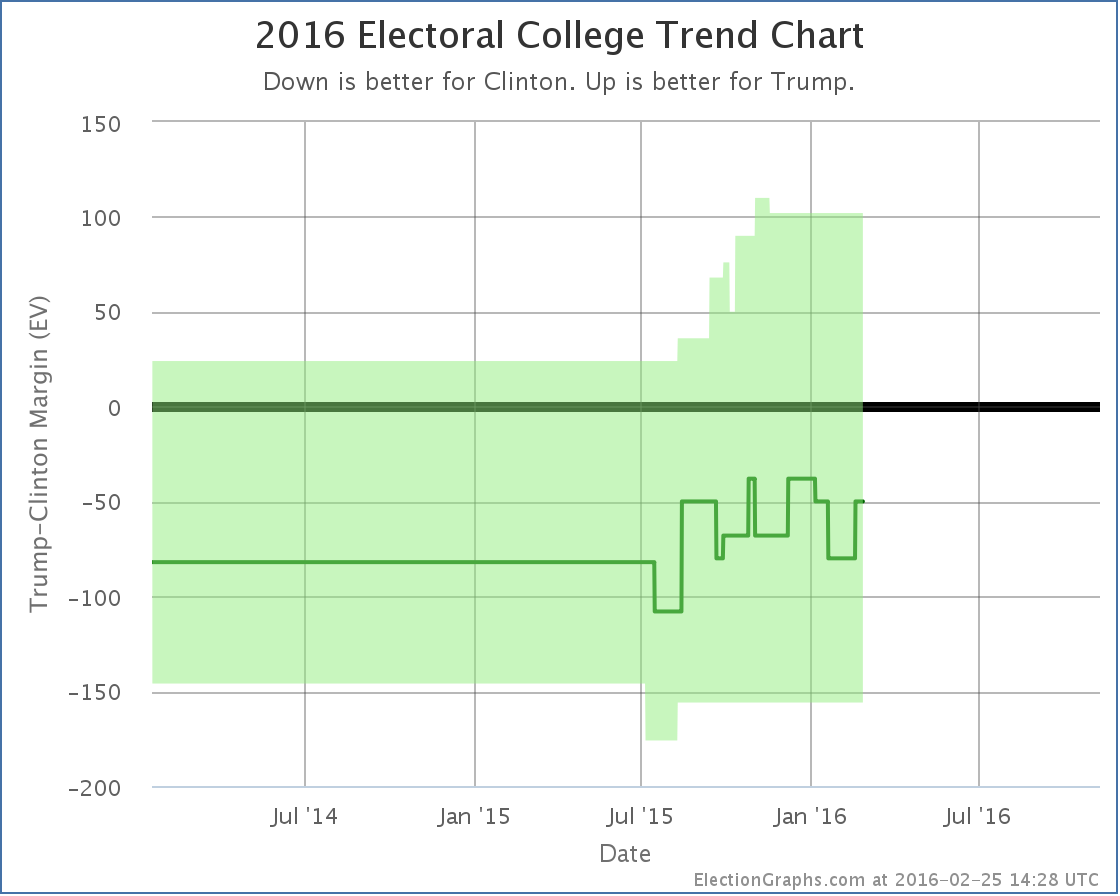
Anything from Clinton winning by 156 electoral votes to Trump winning by 102 electoral votes is plausible given the state polls. Clinton winning by 50 electoral votes is the “expected” result if each candidate wins all the states they are ahead in right now.
Clinton vs Rubio
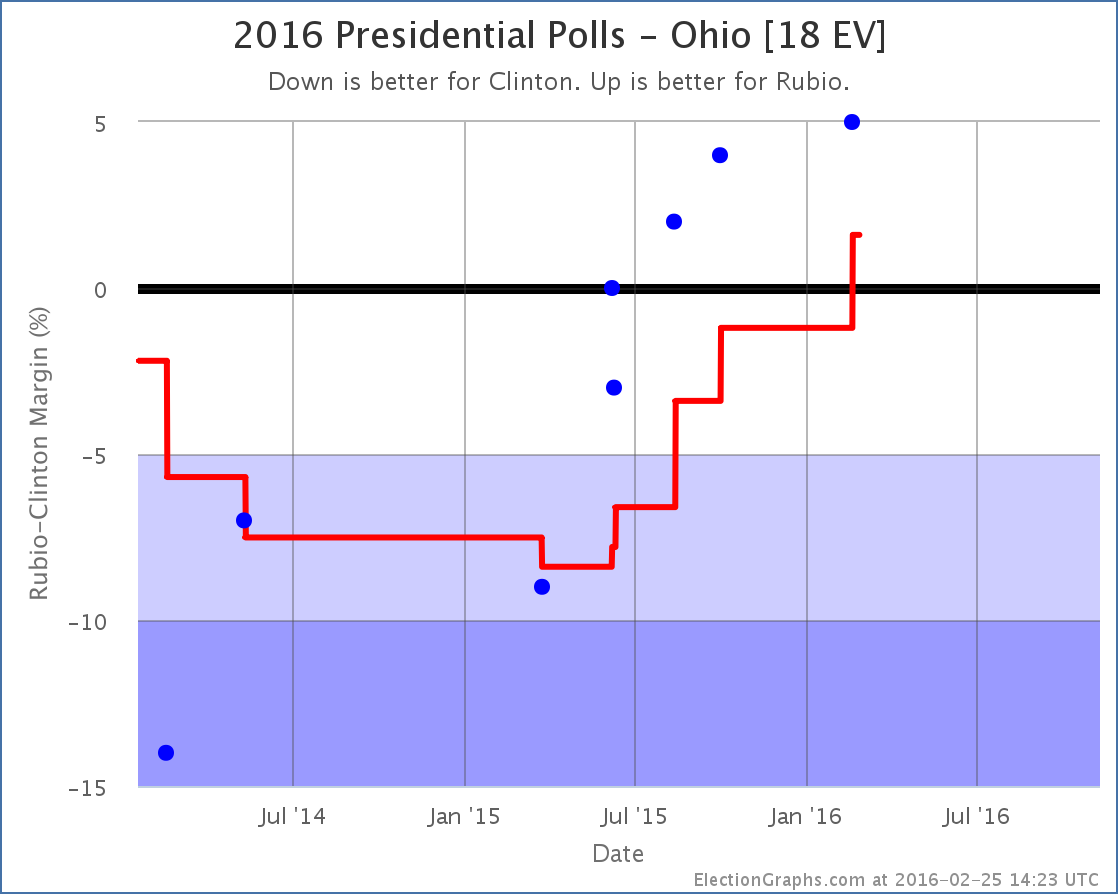
Ohio has been polled less often than one might expect for a state that is traditionally in the “swing state” category, and which looks like it might be again. But the polls for the last year or so have been trending in Rubio’s direction. With this poll, the average pops into the plus side for Rubio. He now leads in Ohio by 1.6% in the average. To be clear, that is still a very close race. But he now has the advantage, so we put Ohio on his side of the ledger.
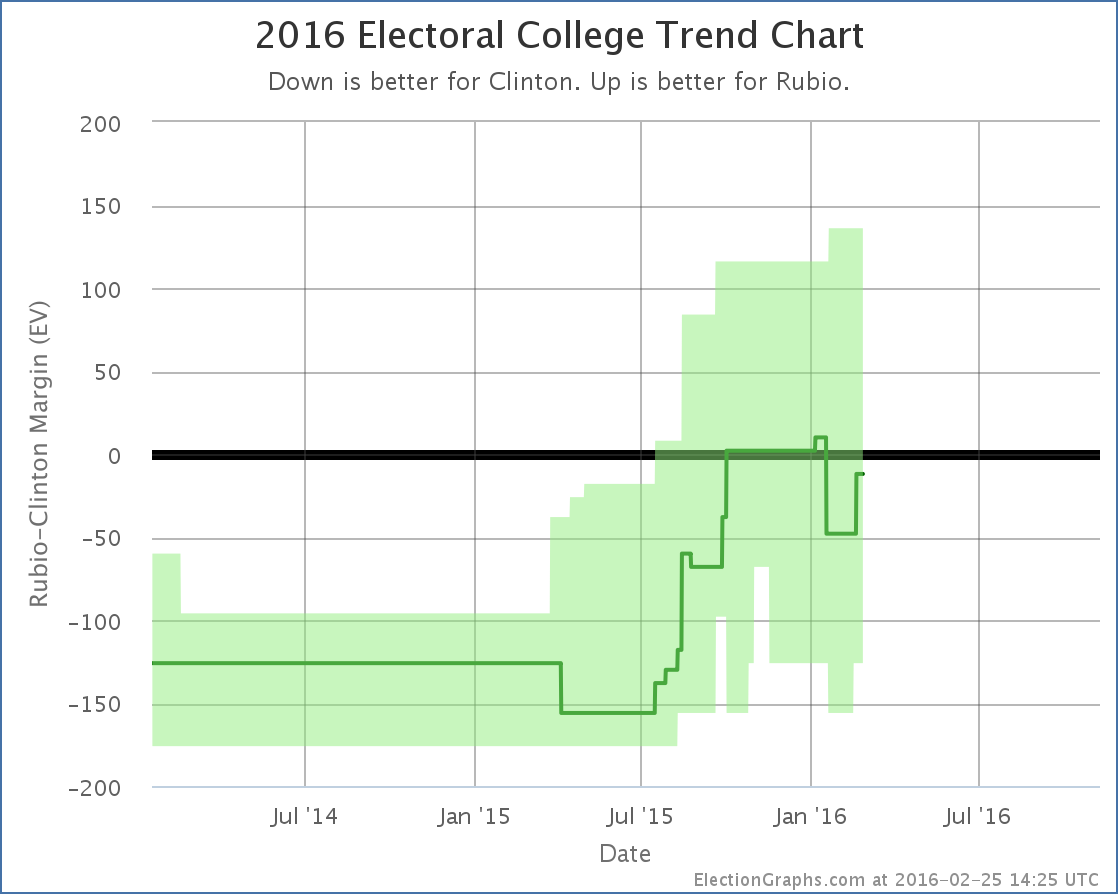
With Ohio back in his column again, if Rubio won every state he is ahead in, and Clinton won every state she is ahead in, Rubio would fall just 12 electoral votes short. He’s not back to leading the race yet, but it is very close. Flipping any one of Florida (0.2% Clinton lead), Virginia (1.2% Clinton lead), Minnesota (1.5% Clinton lead), Michigan (2.9% Clinton lead), or Nevada (4.5% Clinton lead) would do it.
With the large number of close states, anything from Clinton winning by 126 to Rubio winning by 136 would not be surprising though.
Clinton vs Cruz
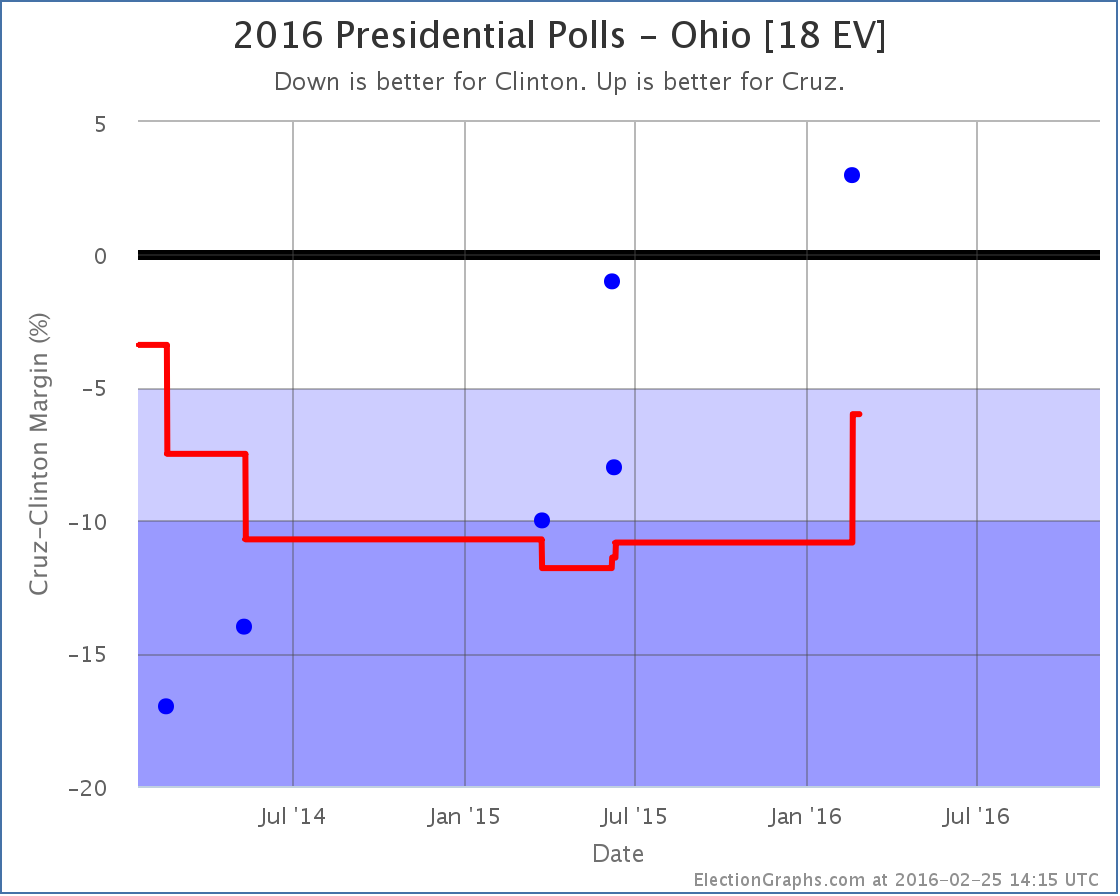
Cruz hasn’t managed to make Ohio competitive against Clinton yet, she still leads him by 6.0% in the poll average, but because with this update Ohio moved past the previous “tipping point state”, the tipping point here moves a bit toward Cruz.
As a reminder, the tipping point is the margin in the state that would put the winning candidate “over the edge” in the electoral college if you order the states by how strongly they support the candidates. Like this:

Prior to this update, the tipping point in Clinton vs Cruz had been Florida, where Clinton led by 6.6%. Now the tipping point is Virginia, where Clinton leads by 6.4%.
The tipping point is essentially like looking at the national popular vote, except it takes into account the structure of the electoral college. It tells you how far the polls would have to move across the board in all states to flip the winner.
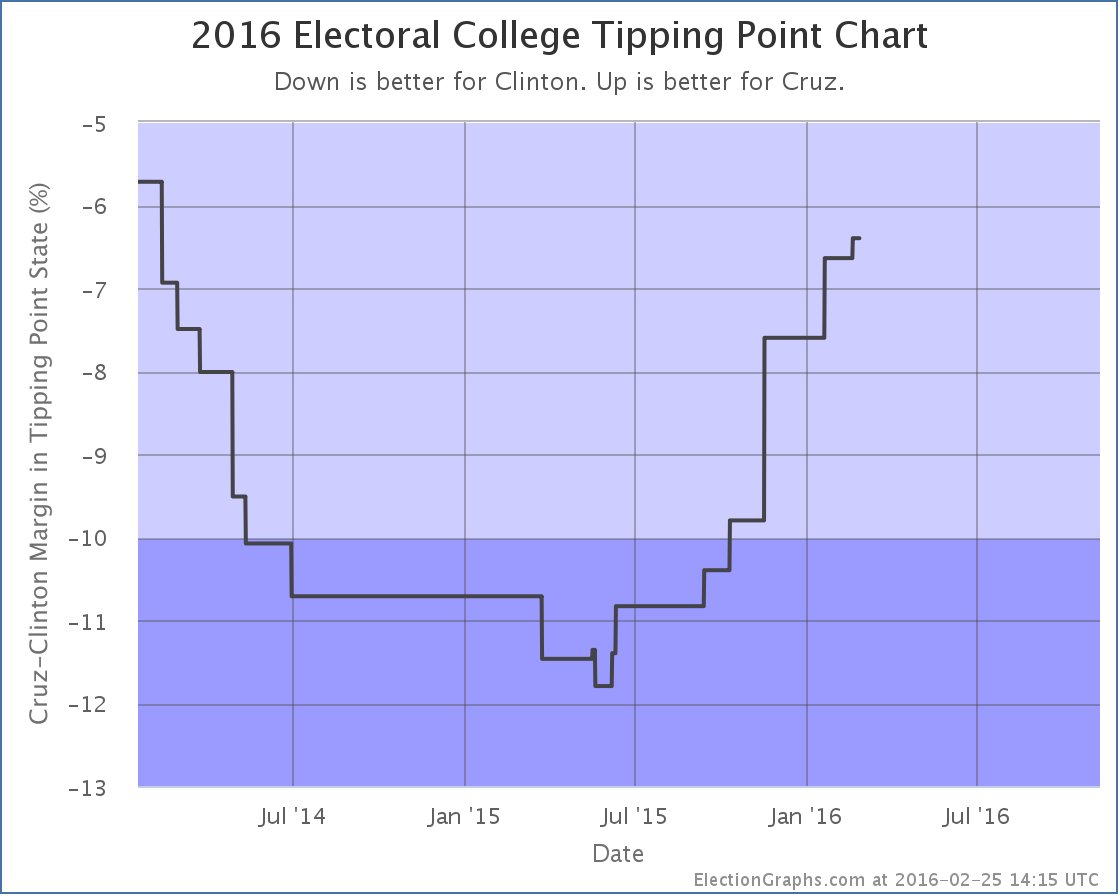
Cruz trails Clinton by 6.4% in this metric… but he has slowly but surely been improving his position since last May. It would take a bit more movement before he actually looked competitive with Clinton though.
And that is where things are today.
256.7 days until polls start to close on election night.
Note: This post is an update based on the data on ElectionGraphs.com. Election Graphs tracks both a poll based estimate of the Electoral College and a numbers based look at the Delegate Races. All of the charts and graphs seen in this post are from that site. Additional graphs, charts and raw data can be found there. All charts above are clickable to go to the current version of the detail page the chart is from, which may contain more up to date information than the snapshots on this page, which were current as of the time of this post. Follow @ElectionGraphs on Twitter or like Election Graphs on Facebook to see announcements of updates or to join the conversation. For those interested in individual general election poll updates, follow @ElecCollPolls on Twitter for all the polls as they are added.
General Election state polls have been few and far between since we are in the heart of the primary battles, but we did get a new PPP North Carolina poll and when it gets factored into my poll averages, it resulted in a couple of category changes worth noting:
Clinton vs Trump

As you can see, North Carolina has been bouncing between “Weak Clinton” and “Weak Trump” ever since there was substantial polling here for Clinton vs Trump in the fall. With this latest update to the average, North Carolina flips back into Trump’s column.
The reality here is that regardless, North Carolina looks close, and could easily go either way, but it moves the center “expected” line in our chart showing the range of plausible electoral results:
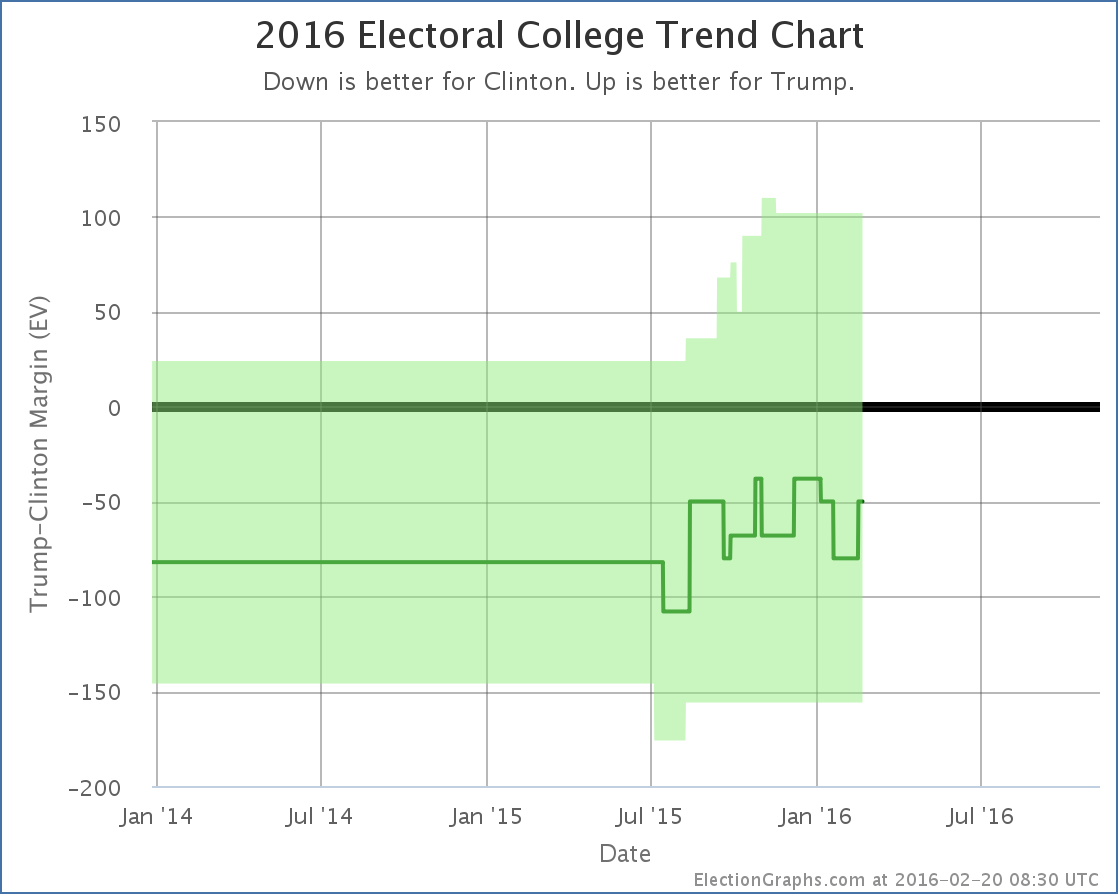
Trump’s “Expected” case, where he wins every state where he leads the poll average, and loses those where he doesn’t, is to lose to Clinton by 50 electoral votes. Trump remains well within reach though. If he were to take the lead in only Iowa, Ohio, and Michigan he would take an electoral college lead. If he were to take all the close states, he would end up winning by 102 electoral votes.
Clinton vs Rubio
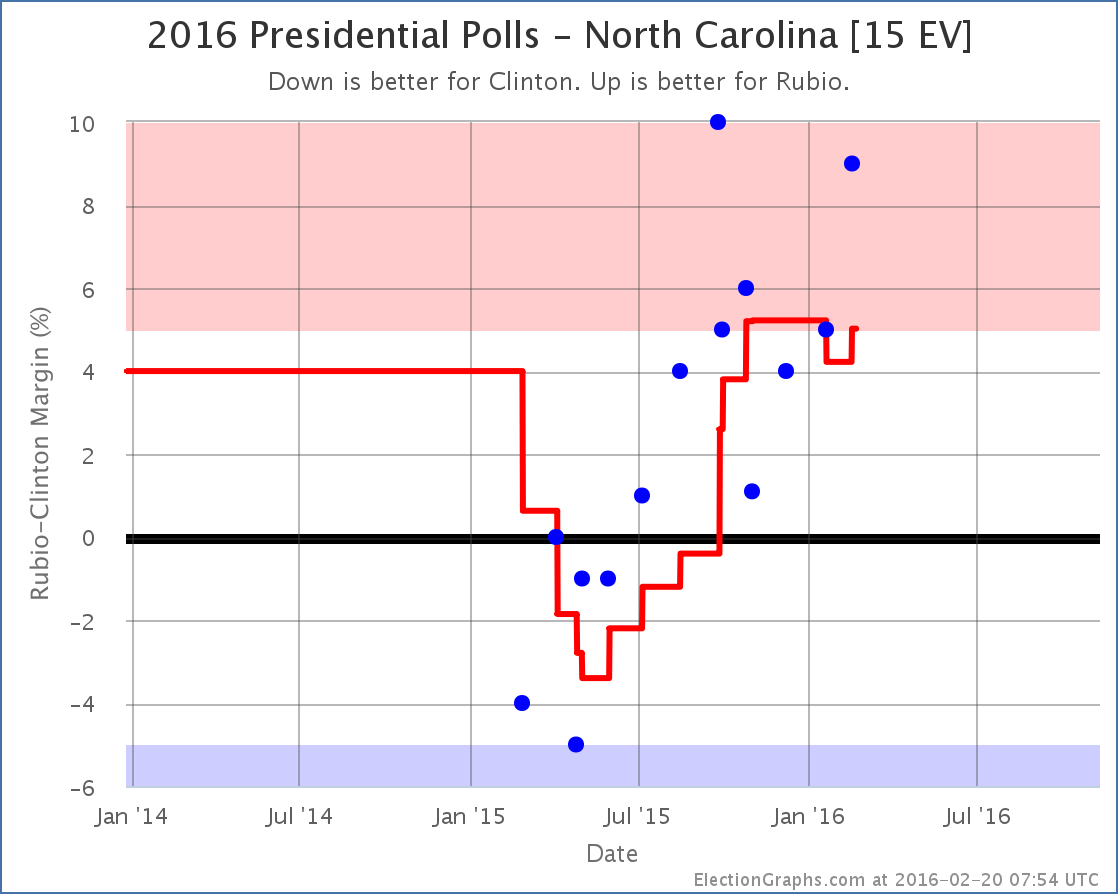
Rubio has been doing substantially better in North Carolina than Trump. Rather than bouncing around near the zero line, this has been hovering near the 5% line that I use to separate “Weak Rubio” from “Strong Rubio”. This update pushes the average to a lead just barely over 5%, so I remove North Carolina from the list of possible Clinton pick up states. This does not change the “expected” results, but diminishes Clinton’s “best case” scenario where she wins not only the states she currently leads, but also those where she is behind by less than 5%.
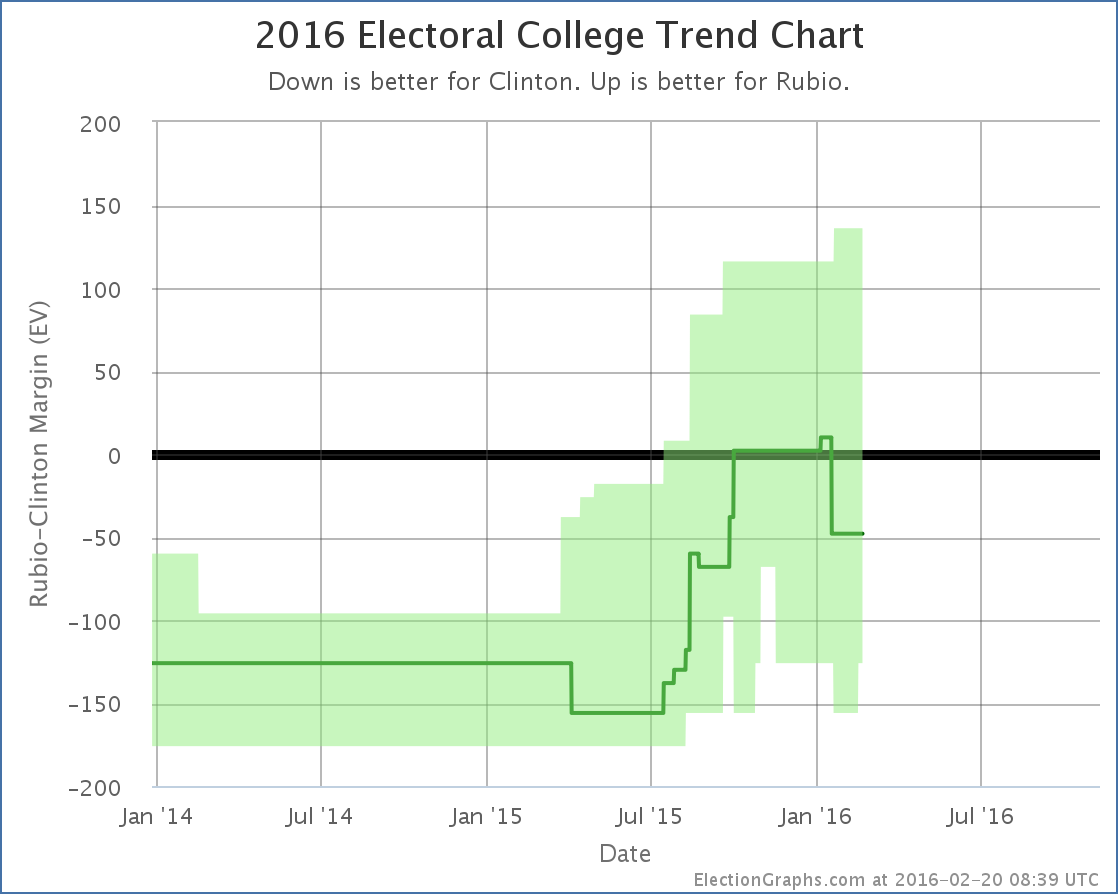
So Clinton’s best case goes from winning by 156 electoral votes, to only winning by 126 electoral votes. The “expected” result remains a 48 electoral vote win by Clinton given the states where she leads in the poll averages.
Once we get clear winners in the primary races, I expect we will stop seeing polling for any candidate combination other than those winners, and general election polling should speed up again. In the mean time, most of the action is going on in the delegate races. Before long though, attention will move back to the general election, and there will be plenty to watch on this side of things too.
262.3 days until the first general election polls start to close.
Note: This post is an update based on the data on ElectionGraphs.com. Election Graphs tracks both a poll based estimate of the Electoral College and a numbers based look at the Delegate Races. All of the charts and graphs seen in this post are from that site. Additional graphs, charts and raw data can be found there. All charts above are clickable to go to the current version of the detail page the chart is from, which may contain more up to date information than the snapshots on this page, which were current as of the time of this post. Follow @ElectionGraphs on Twitter or like Election Graphs on Facebook to see announcements of updates or to join the conversation. For those interested in individual general election poll updates, follow @ElecCollPolls on Twitter for all the polls as they are added.
Most attention right now continues to be on the primary races, as we are in the days between Iowa and New Hampshire, and things are still very unsettled and exciting. But there have been a handful of new general election polls. The latest change to mention is in the matchup between the delegate frontrunners in both parties.
Clinton vs Cruz
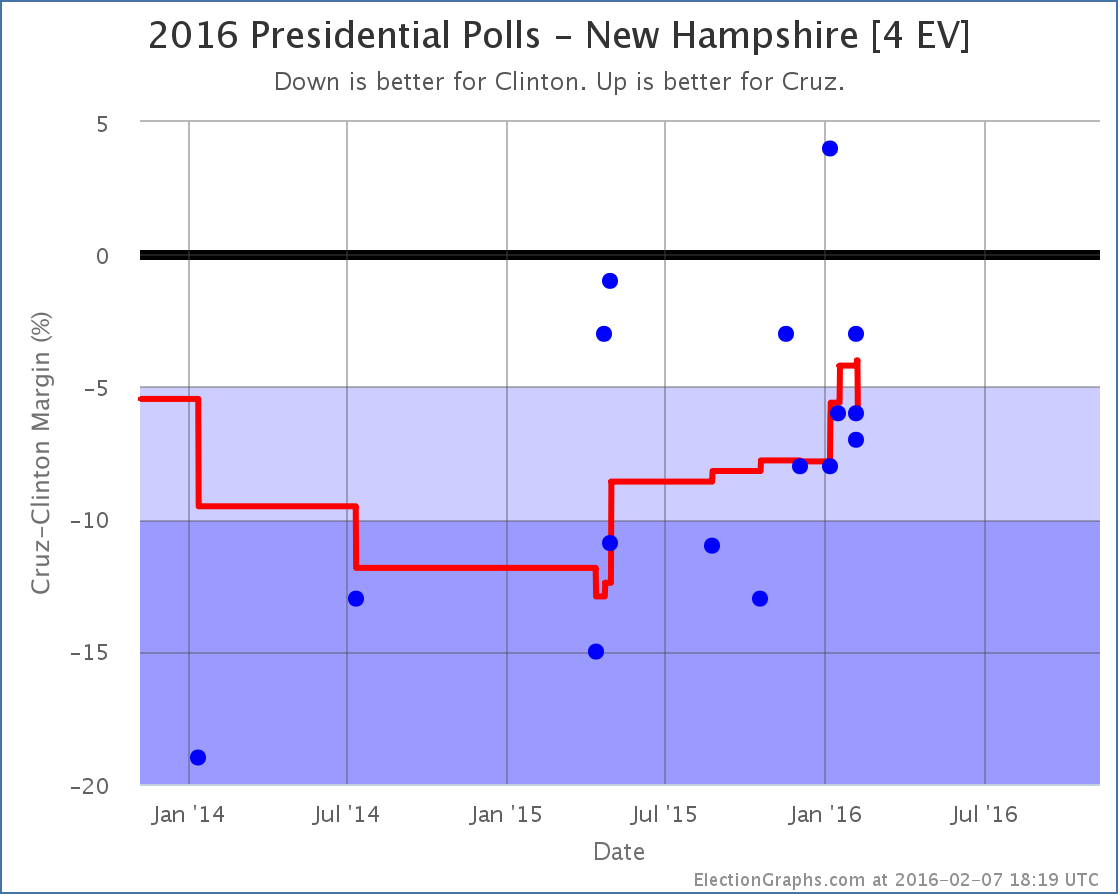
For a few short weeks, some favorable polls for Cruz moved New Hampshire from “Strong Clinton” to “Weak Clinton”, meaning that the poll average showed a Clinton lead of less than 5%, so we considered the state “possible” for Cruz and included it in Cruz’s best case.
In this update Clinton’s lead in the New Hampshire poll average against Cruz is back up to 6.0%, so New Hampshire seems like it is off the table for Cruz again.
This moves Cruz’s best case from losing to Clinton by 76 electoral votes to losing by 84 electoral votes. The “Expected” case where each candidate wins all of the states they are ahead in the poll average, with no states flipping, still has Cruz losing by 96 electoral votes.
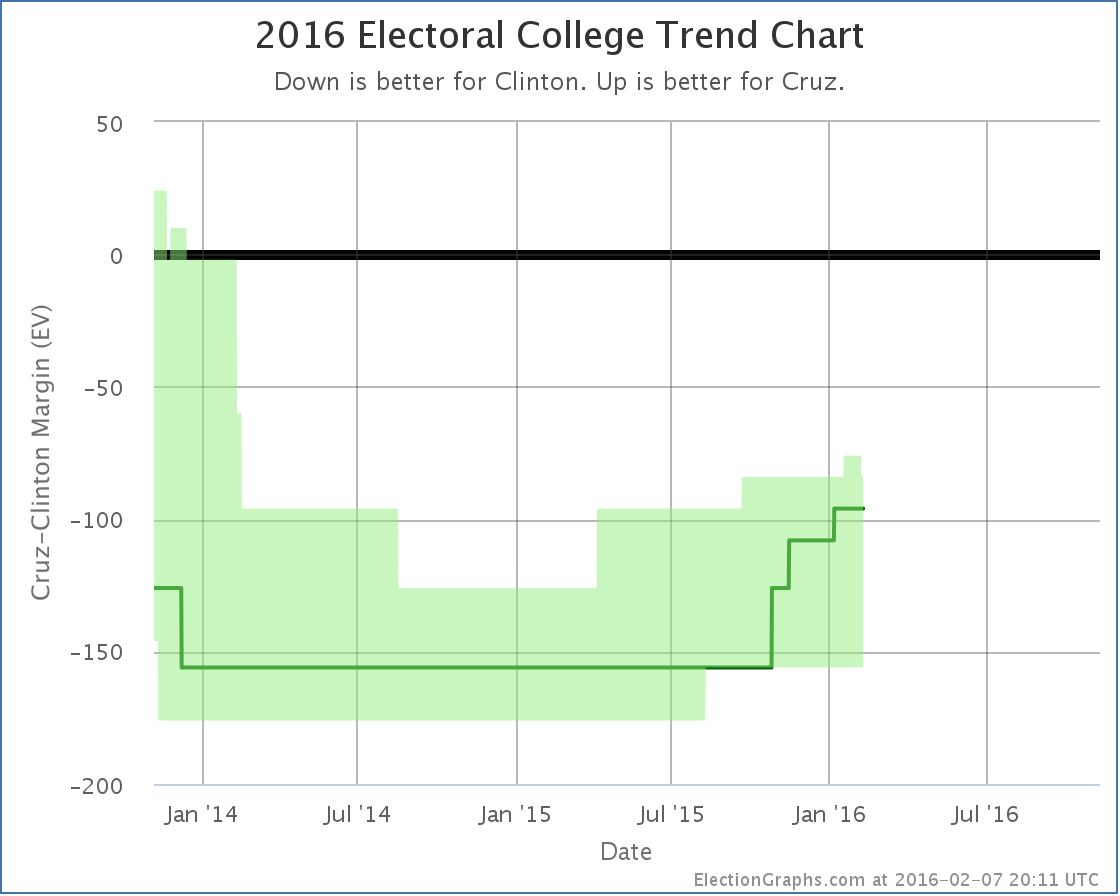
Cruz is well behind Clinton in these electoral college estimates. (Popular vote polling is more positive to him though.). But his best case, worst case, and expected case have all been improving over the last year. Today’s change is the first one in which his position has gotten worse since August 2014, which frankly was before there were enough polls to give a reliable picture.
The question is of course if this is a sign of additional movement to come. Is this the best that Cruz can do against Clinton? The popular vote numbers I pointed to earlier indicate that Cruz probably can indeed do better than this, and perhaps we’re not seeing it in the electoral college numbers just because we don’t have enough recent polling in enough states. Or maybe we really do have a popular vote / electoral college disconnect. It is possible.
In any case, it would be premature to think that Cruz has topped against Clinton. We have a very long way to go. If Cruz continues to be the Republican delegate frontrunner, or even close, we’ll continue to get more polling and a better picture of how a Clinton vs Cruz race would go, and of course things will look different once the general election campaign starts in earnest.
Of course, if Cruz falls behind in the delegate race, polling involving him will dry up in favor of whoever is leading in his place. And nobody will miss it. :-)
275.1 days until general election polls start to close!
Note: This post is an update based on the data on ElectionGraphs.com. Election Graphs tracks both a poll based estimate of the Electoral College and a numbers based look at the Delegate Races. All of the charts and graphs seen in this post are from that site. Additional graphs, charts and raw data can be found there. All charts above are clickable to go to the current version of the detail page the chart is from, which may contain more up to date information than the snapshots on this page, which were current as of the time of this post. Follow @ElectionGraphs on Twitter or like Election Graphs on Facebook to see announcements of updates or to join the conversation. For those interested in individual general election poll updates, follow @ElecCollPolls on Twitter for all the polls as they are added.
With just a few days until Iowa, the concentration is naturally on the delegate races, but general election polling continues as well. Until we have actual delegate counts, we’re still following changes for the five best polled candidate combination. With the newest batch of polls, we have two of the Republicans strengthening their position against Clinton in Minnesota.
Clinton vs Rubio
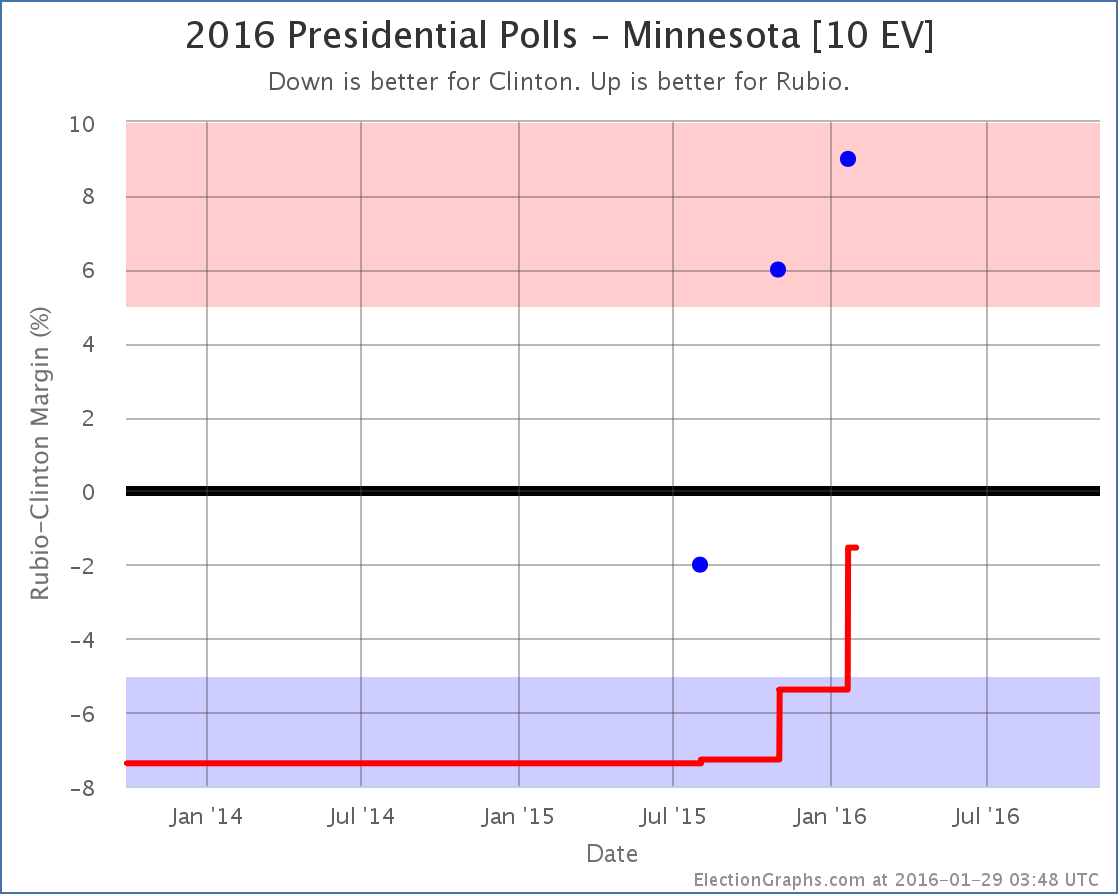
There hasn’t been a lot of polling in Minnesota, but what there is has been tilted further toward the Republicans than the five election average I use as a starting point for my poll averages. With the latest poll, the average moves to a Clinton lead of only 1.5%. This makes Minnesota start looking like a pretty close state. It makes Minnesota a possible pick up for Rubio, and therefore improves his “best case” against Clinton:
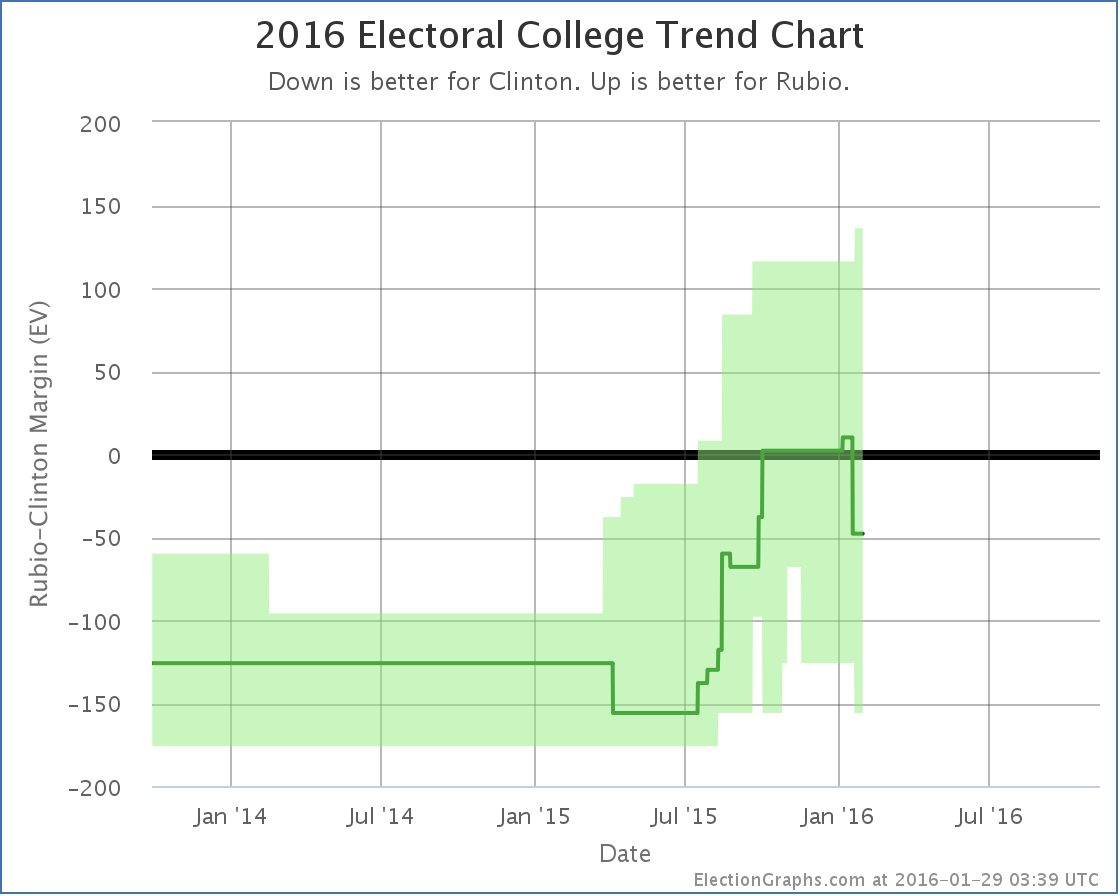
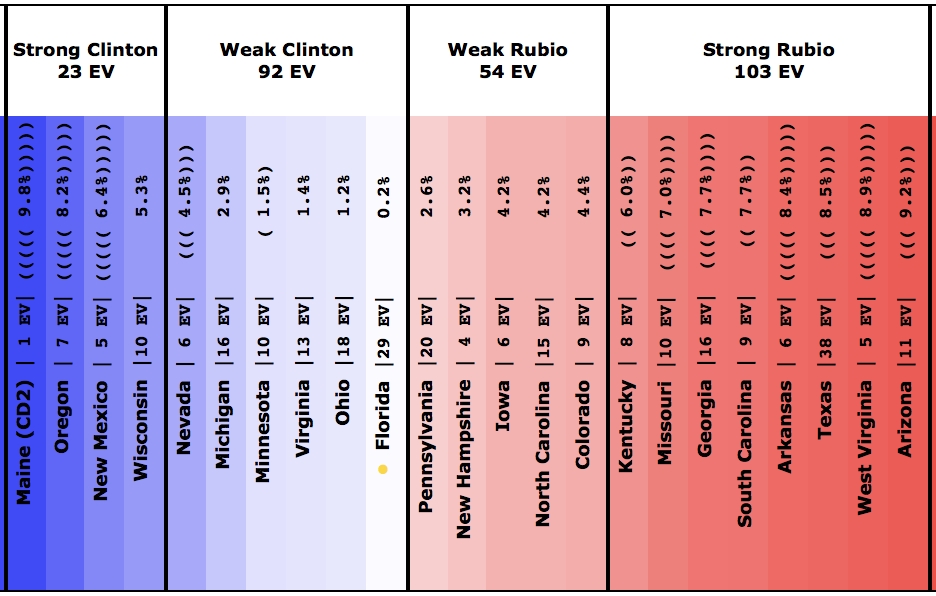
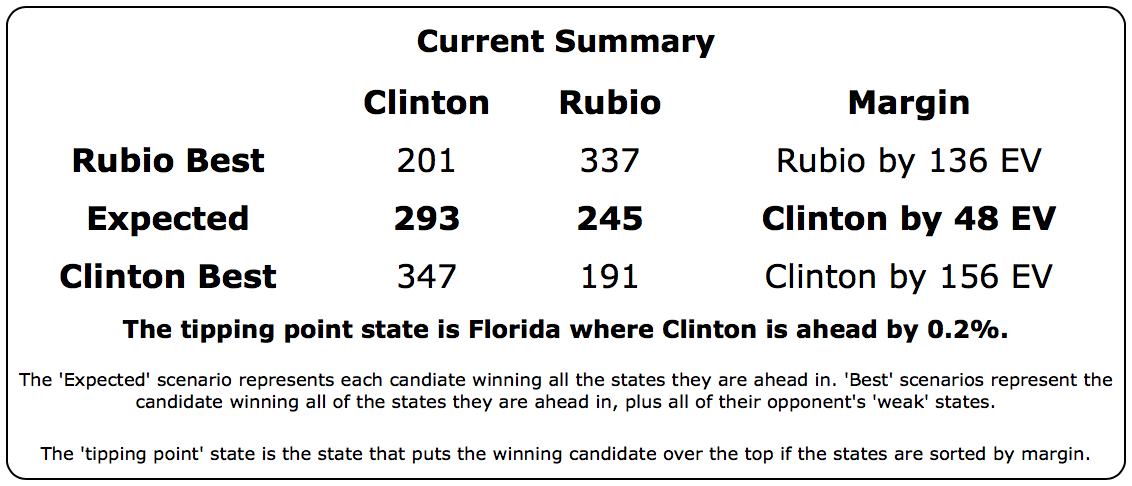
What’s remarkable looking at Clinton vs Rubio at this point is the huge number of close states. There are 146 electoral votes in the “up for grabs” category, where the polling margin is under 5% and it would be very easy to imagine the state going either way. Add to that that the tipping point is only a 0.2% Clinton lead, and Clinton vs Rubio is the most evenly matched of the five best polled candidate combinations by a decent margin. The race is very close, and the “best cases” for the two candidates are relatively close to being symmetric.
If the Republican race was about picking the candidate most likely to beat Clinton, Rubio would be way ahead. But it isn’t, and he isn’t.
Clinton vs Cruz
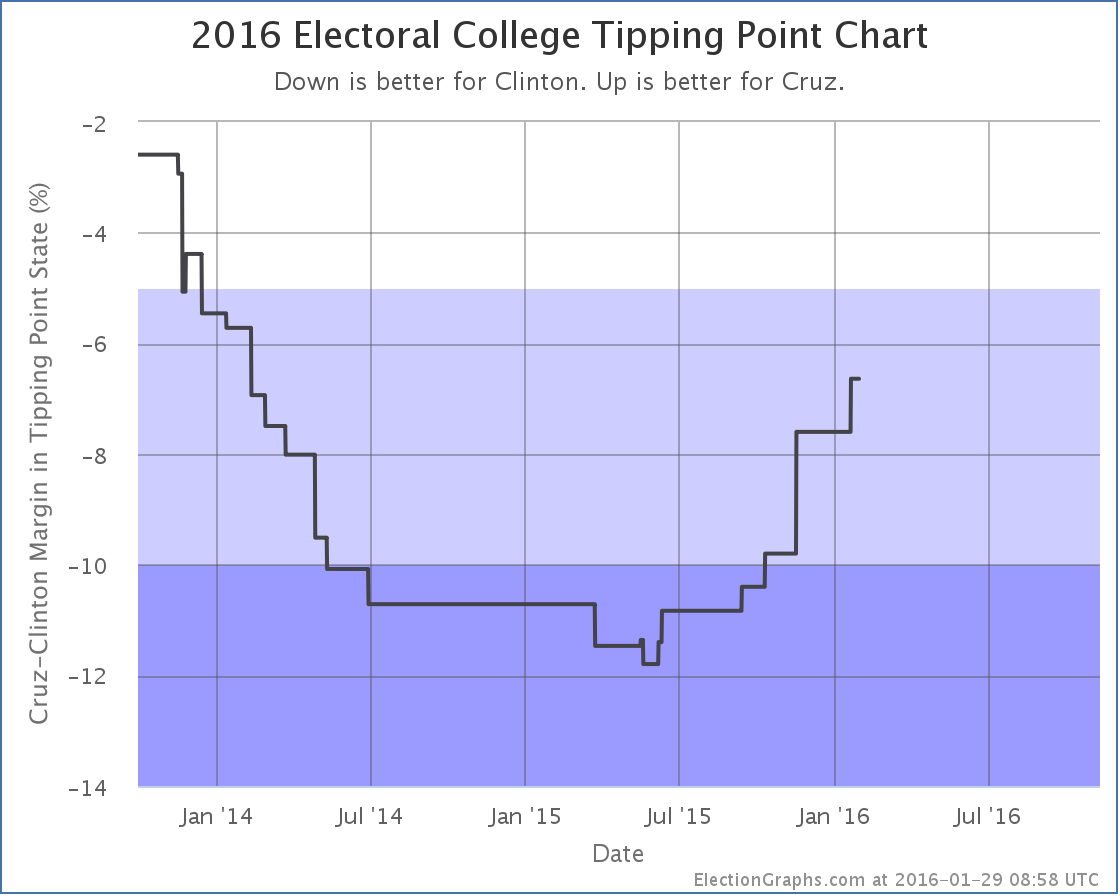
Cruz improved in Minnesota from being behind Clinton by 8.8%, to only being behind by 6.3%. This did not result in a category change, but it did move the tipping point… the state that puts the winning candidate over the edge if you put the states in order. We go from the tipping point being Virginia with a 7.6% Clinton lead, to being Florida with a 6.6% Clinton lead. This still means Cruz is very far behind. He is clearly losing to Clinton. It isn’t particularly close. But it is closer than it was. Cruz has been consistently improving on this metric since June. If Cruz stays in contention in the primaries, watch this number to see if this trend continues and Cruz starts making it an actually competitive race, or if Clinton vs Cruz continues to look like an easy Clinton win.
Clinton vs Trump
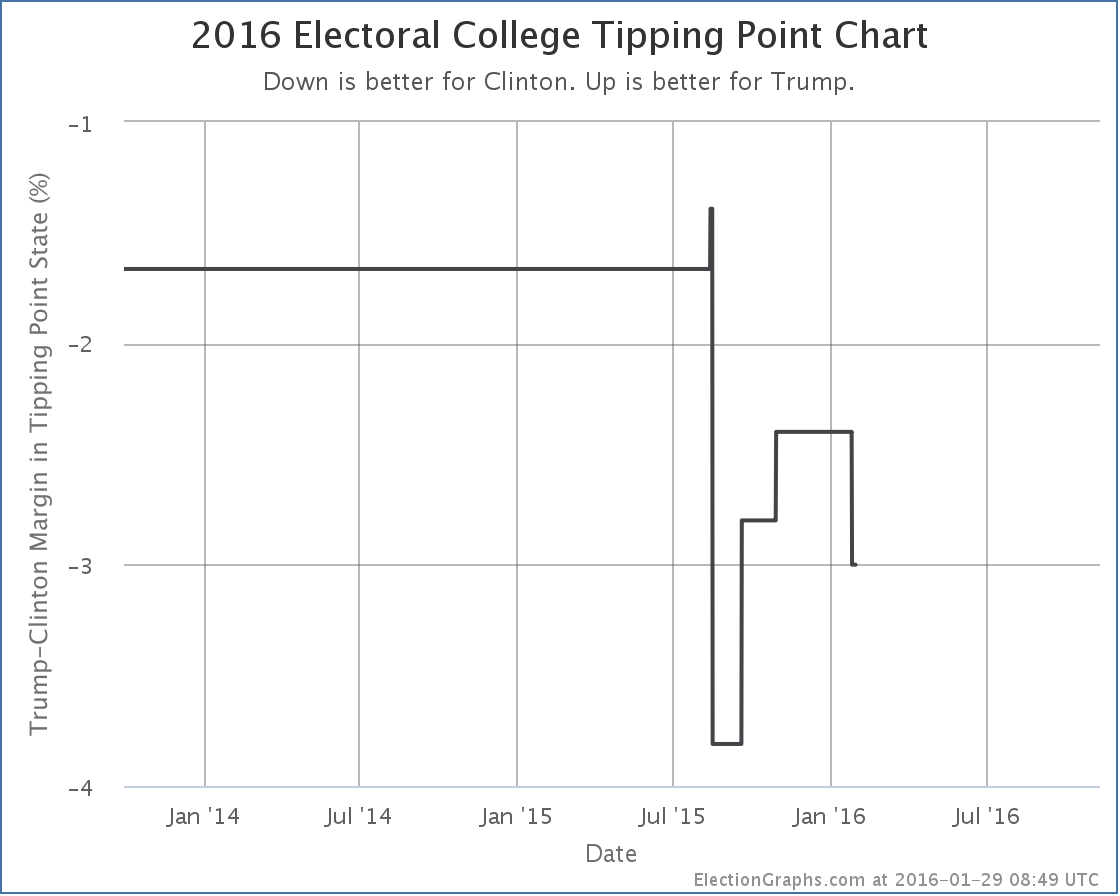
OK, technically Clinton vs Trump is #6 in terms of how well polled the candidate combination is, which means by my rules I wouldn’t be talking about it right now. But given Trump’s position in the polls, I’ll mention it anyway. New Clinton vs Trump polling in Michigan (not in Minnesota like the other two) increases Clinton’s lead from 2.4% to 3.0%. This does not move Michigan to a new category, but it does move the tipping point. In this case the tipping state was and still is Michigan, so the tipping margin just moves from 2.4% to 3.0%. There isn’t enough here to declare a real trend. And both 2.4% and 3.0% are “close”. So either way, a Clinton vs Trump race is one with a small Clinton advantage, but still a race that could go either way.
In just a few more days, we’ll have actual delegate leaders in both parties. Things are moving fast.
284.6 days until polls start to close on Election Day 2016.
Note: This post is an update based on the data on ElectionGraphs.com. Election Graphs tracks both a poll based estimate of the Electoral College and a numbers based look at the Delegate Races. All of the charts and graphs seen in this post are from that site. Additional graphs, charts and raw data can be found there. All charts above are clickable to go to the current version of the detail page the chart is from, which may contain more up to date information than the snapshots on this page, which were current as of the time of this post. Follow @ElectionGraphs on Twitter or like Election Graphs on Facebook to see announcements of updates or to join the conversation. For those interested in individual general election poll updates, follow @ElecCollPolls on Twitter for all the polls as they are added.
My primary race delegate tracking for both parties will be out very soon… promise. In the mean time, rather than just looking at the delegate leaders on each side against each other, we continue to concentrate on the five best polled candidate combinations.
With a batch of new polls added in North Carolina, Florida, and New Hampshire, it starts to look like the long trend of Clinton getting weaker and weaker against a wide variety of Republican rivals may have ended. Maybe. For now. A little bit. Things will change before we are done. Polls like these aren’t predictive of the general election until after the conventions. Caveat caveat caveat.
Lets look at each category change by state:
Florida (29 EV)
Of the best five polled candidate combinations, two Republicans have their positions deteriorate against Clinton in this update, Bush and Rubio:
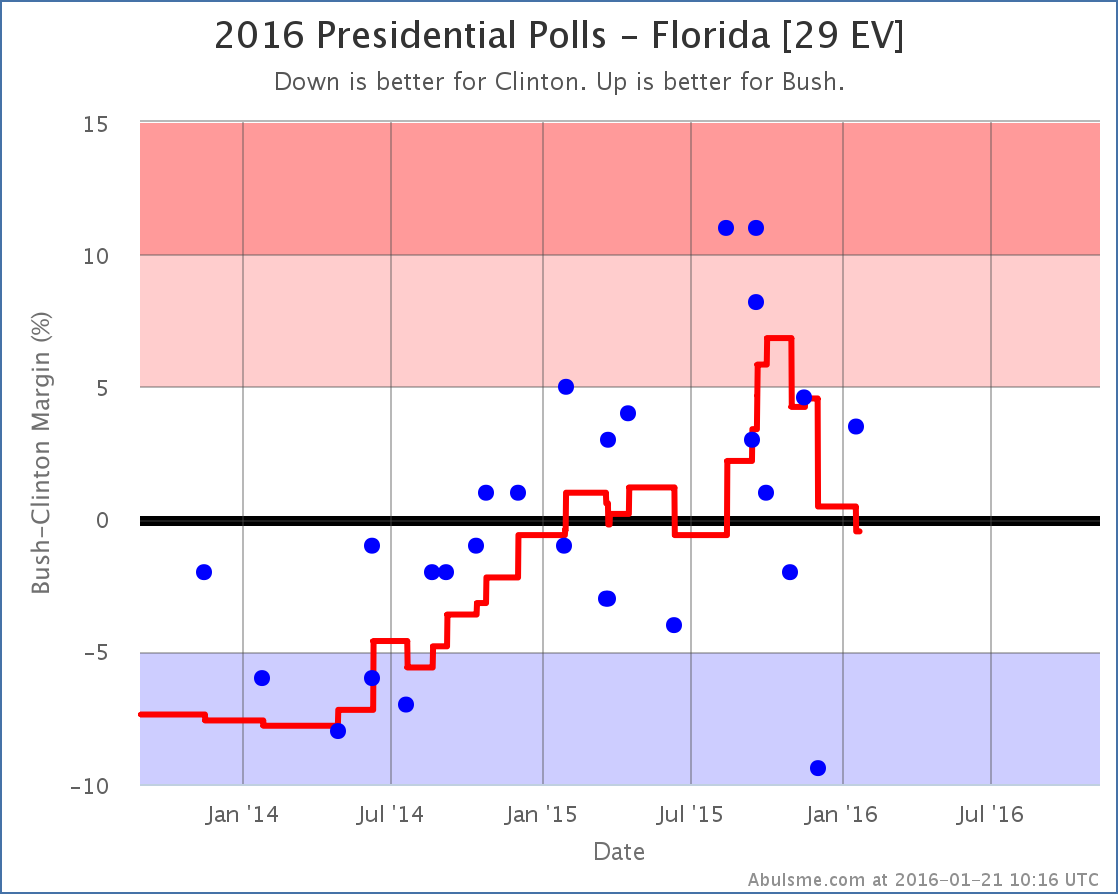
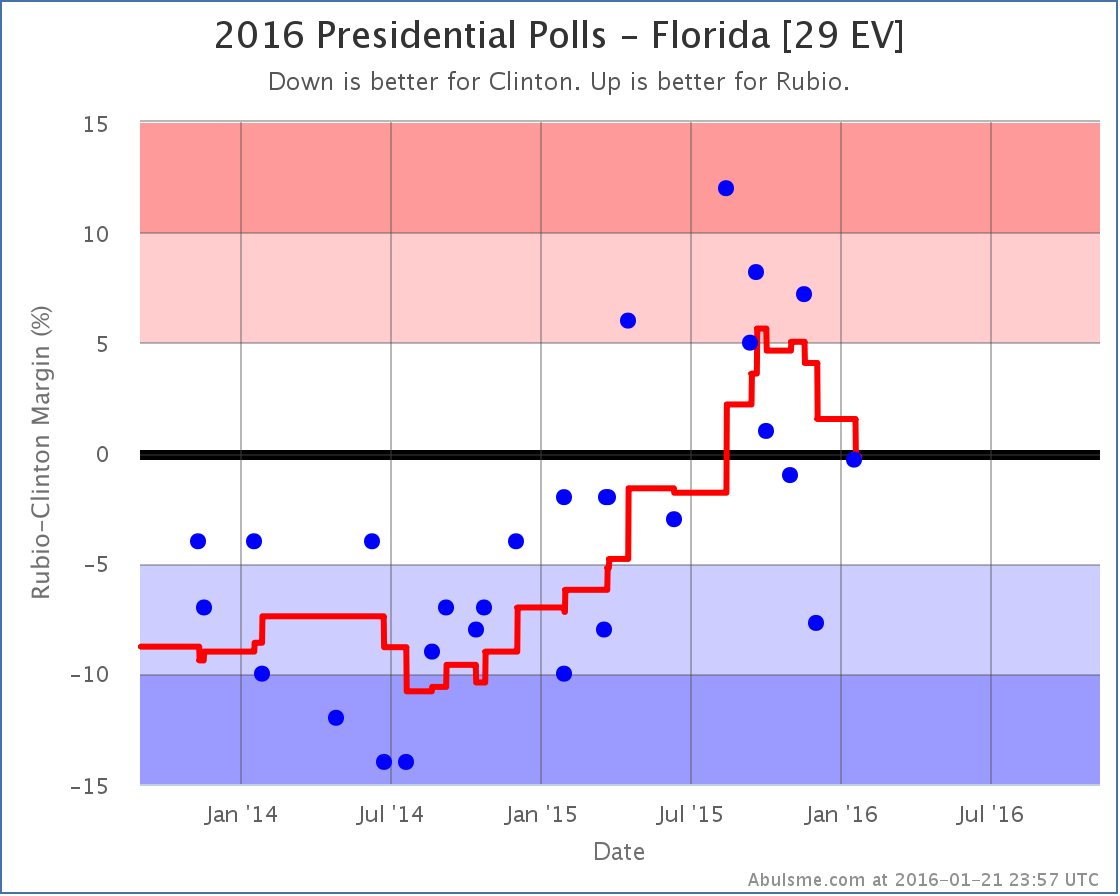
Both candidates seemed to peak in late September or early October, and since then have been weakening. With the latest set of poll updates, both states move from being weakly on the Republican side of the line, to being Weak Clinton. The “weak” here should be emphasized. Clinton’s lead over Bush in the average is only 0.5%, and over Rubio it is only 0.2%. This is about as close as you can get. Since for the analysis here any lead under 5% is considered as one that could easily disappear overnight, at these even smaller margins, this is essentially a tie. But for the last few months, the movement has been in Clinton’s direction.
North Carolina (15 EV)
In North Carolina, once again Bush and Rubio lose ground to Clinton. Although technically with the current update Clinton vs Trump dropped to the 6th best polled candidate combination, I know the Trumpets will want to hear about how he is doing, so I’ll mention that Trump also weakens in North Carolina. Yes, yes, I know that any such indications are just propaganda from the vast establishment conspiracy of which I am a part. But anyway… looking at the charts:
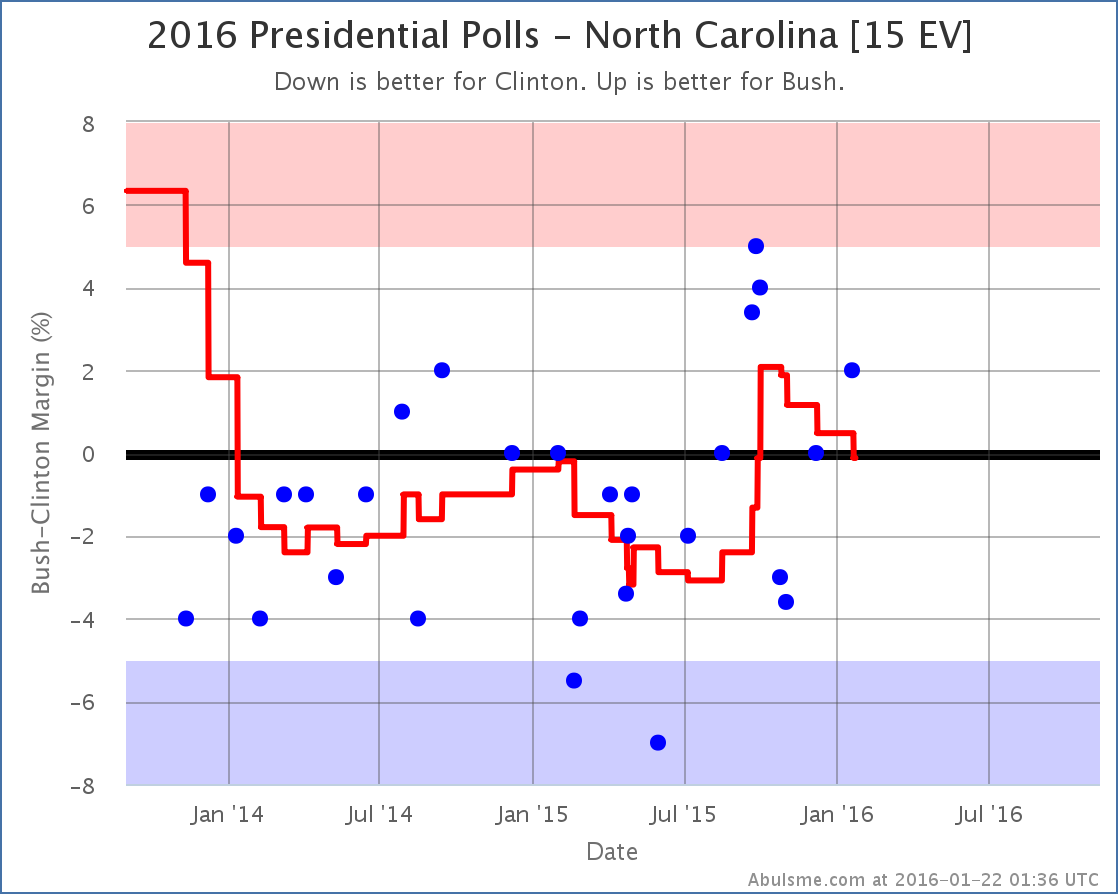
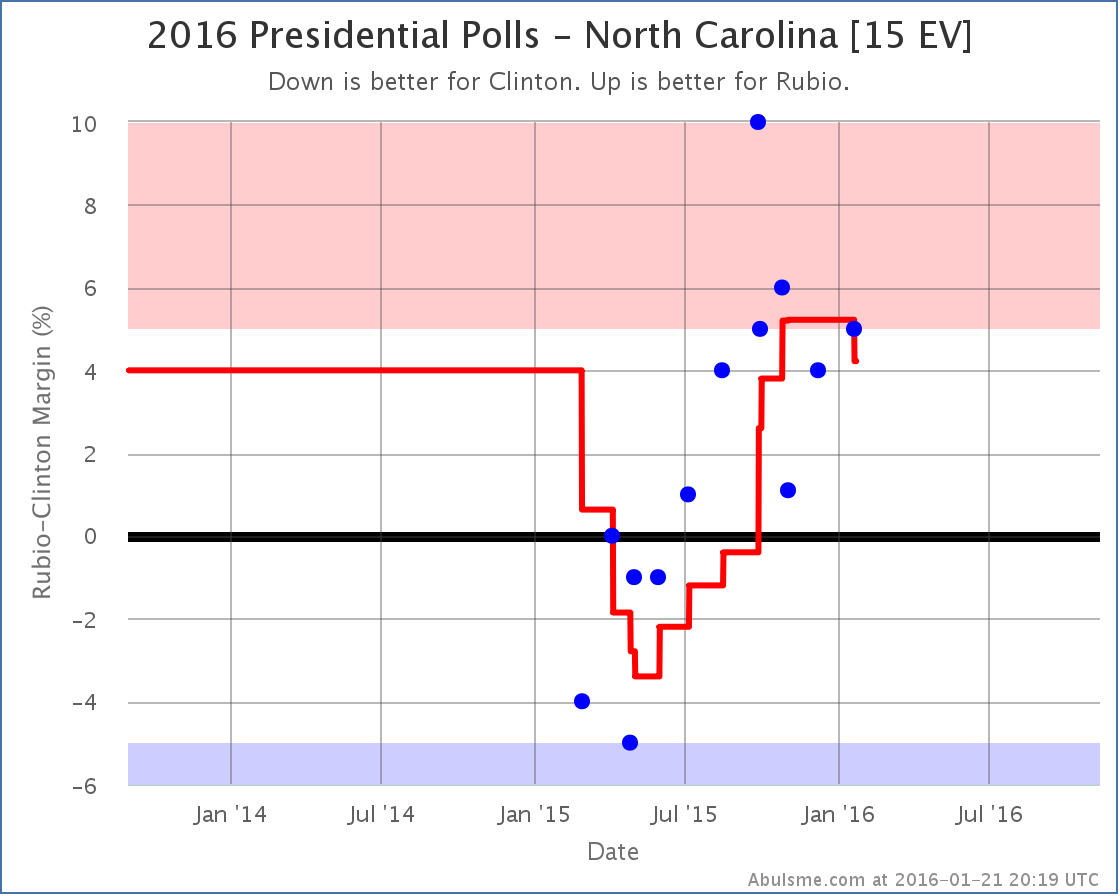
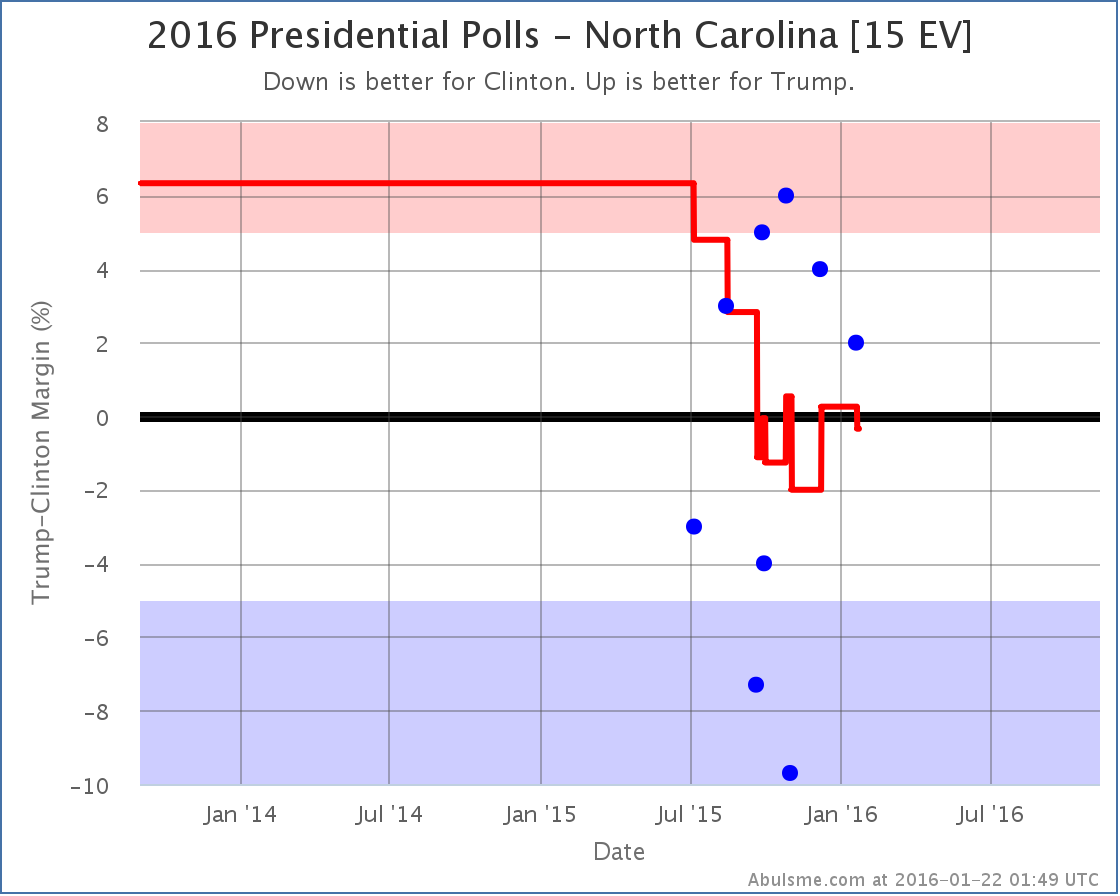
In this case the averages for Bush and Trump against Clinton move from Weak Republican to Weak Clinton, but once again the “weak” is the key here. Clinton leads Bush by 0.1% and Trump by 0.3%. So again, super close. A move from just barely on one side of the line to just barely on the other side of the line isn’t really too meaningful except if it seems part of a larger movement. In the case of Bush, the average seems to have been moving toward Clinton for several months. In the case of Trump, it is more bouncing around in a range over the past few months.
Rubio does a bit better here. North Carolina had actually been in the “Strong Rubio” category for a few months, with the poll average showing a Rubio lead of over 5%. With the latest update, Rubio’s lead slips under 5% to 4.2%, which means I once again consider North Carolina a state that could go either way in this matchup, but Rubio still has a lead.
New Hampshire [4 EV]
New Hampshire is the one state that has good news for the Republicans in this update. No category changes for Bush, Rubio, or Trump… but this time Cruz jumps into a new category.
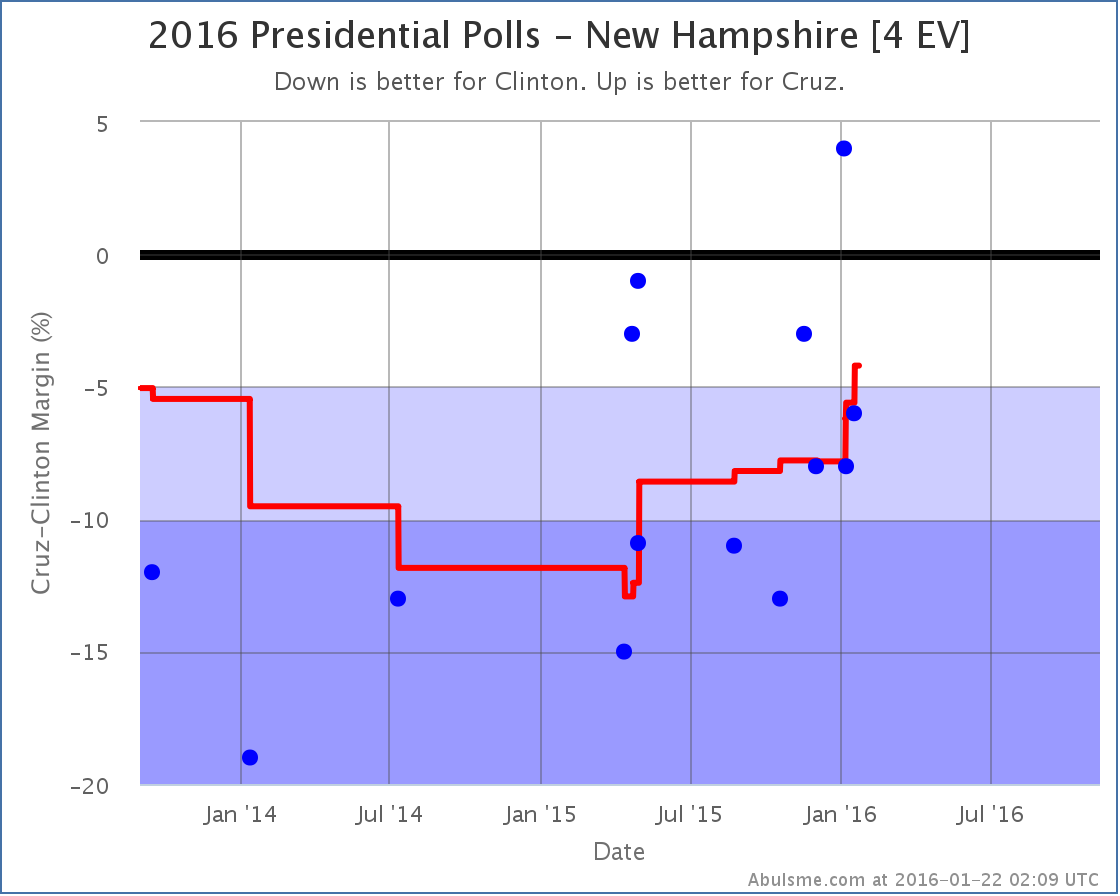
Cruz’s recent movement in New Hampshire is the opposite of the trends we were looking at for the other candidates in the other states. Cruz is gaining on Clinton in New Hampshire. For the first time, the state starts to look competitive in this match up. Clinton is still up 4.2% in the average, but now it is conceivably within reach for Cruz.
National Ranges
So with all these various changes, what do things look like nationally for all these candidate pairs? Here we go:
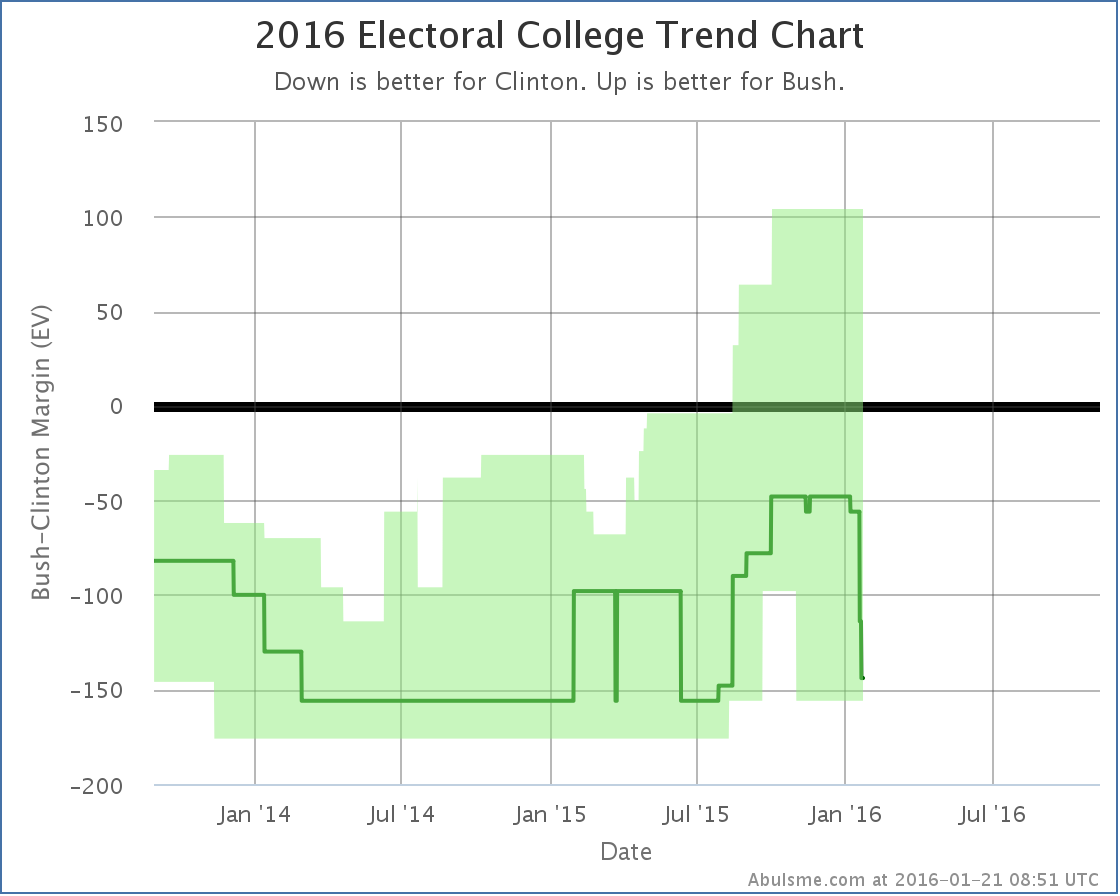
With Florida and North Carolina back out of his column, the result if everybody just wins the states they are ahead in now sits at Bush losing by 144 electoral votes. If he manages to flip the states where Clinton is ahead by less than 5% he could still win by up to 104 electoral votes though, so while Bush is behind, this is still a race.
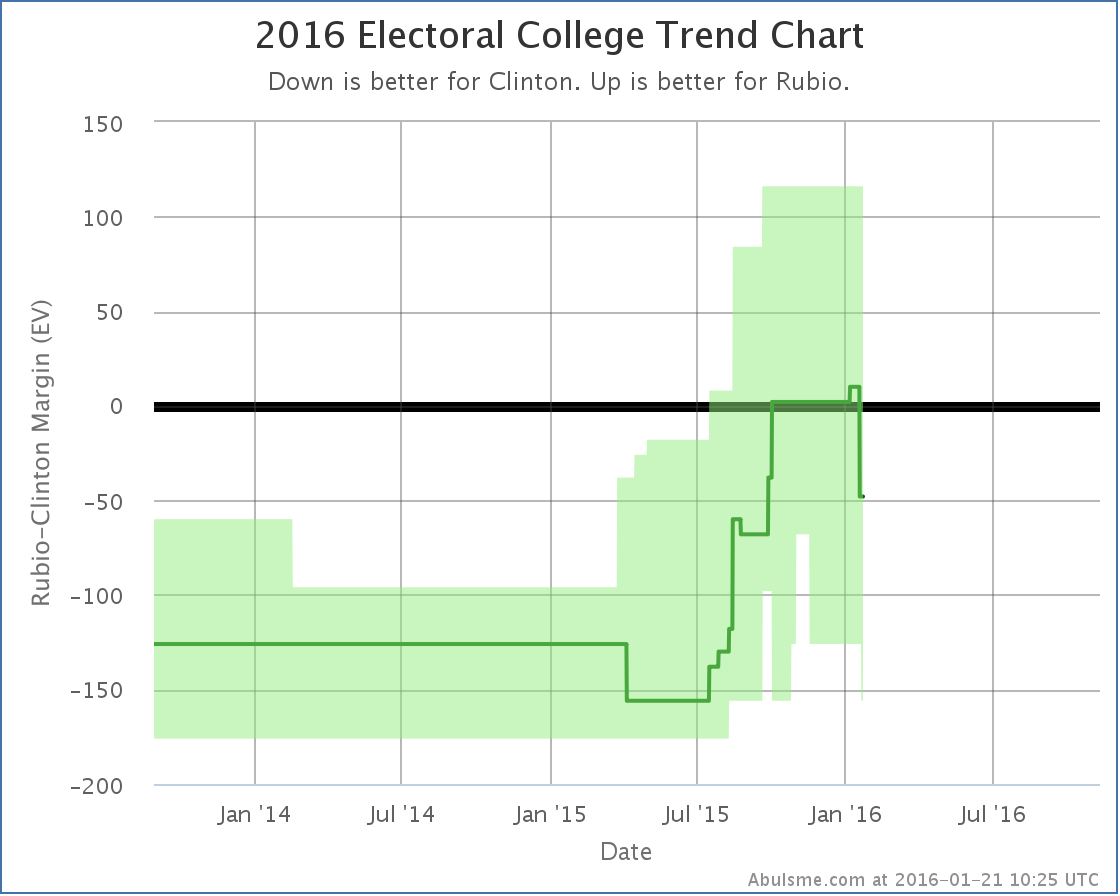
Before this update, Clinton vs Rubio was actually expected to be a narrow 10 electoral vote Rubio win. But if you take Florida away, that changes into a 48 electoral vote loss. With North Carolina also now considered a possibility for Clinton, Clinton’s “best case” improves to a 156 electoral vote win. Rubio’s best case is still a 116 electoral vote win though, so this matchup is also a real race that could go either way.
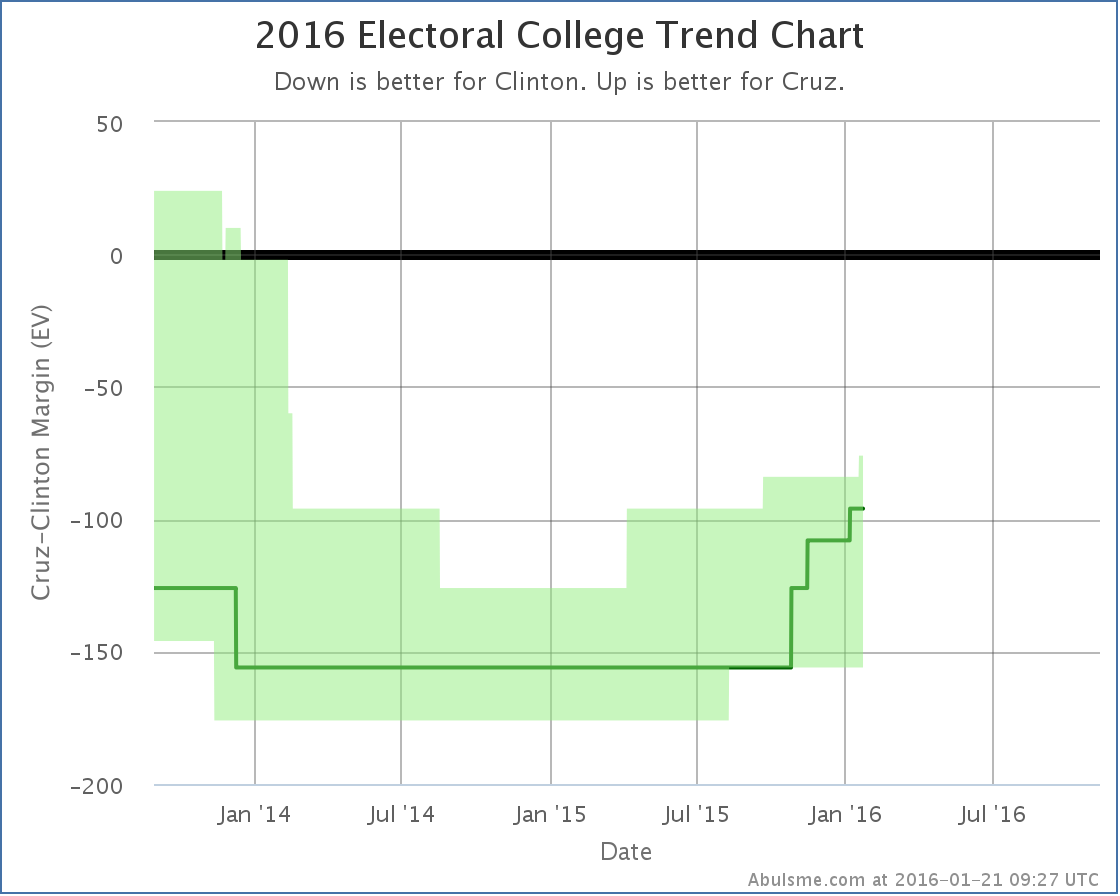
On the other hand… making New Hampshire possible brings Cruz’s best case… where he wins every state he is ahead in, plus all the states where Clinton’s lead is less than 5%… to Cruz losing by 76 electoral votes. This is better than it was. Cruz has been improving since last spring. But he is still not yet in a place that would make a Clinton vs Cruz race even competitive. Right now that matchup looks like an easy Clinton win.
Now, the Real Clear Politics average for Clinton vs Cruz actually shows Cruz ahead of Clinton right now. (Rubio too.) How does this mesh? First thing to note is that the state level polling that the estimates on this site are based on are still not happening quickly enough to show national movement that happens on timeframes less than a few months. So it is quite possible there has been a recent move just isn’t reflected in the state numbers yet. If so, if Cruz ends up the nominee, there will be a lot more polling, and we’ll see the state level analysis move toward the national numbers as more data becomes available. It is of course also possible that Cruz’s support is distributed between states in such a way that gives him a popular vote advantage while still leaving him behind in the electoral college. To be frank though, that is less likely.
Given that, it is reasonable to think that perhaps the gains Cruz showed in the New Hampshire update today are quite likely happening in other states as well, there just isn’t the polling available yet to show it on a state by state basis. So Cruz may be stronger than he appears on this chart.
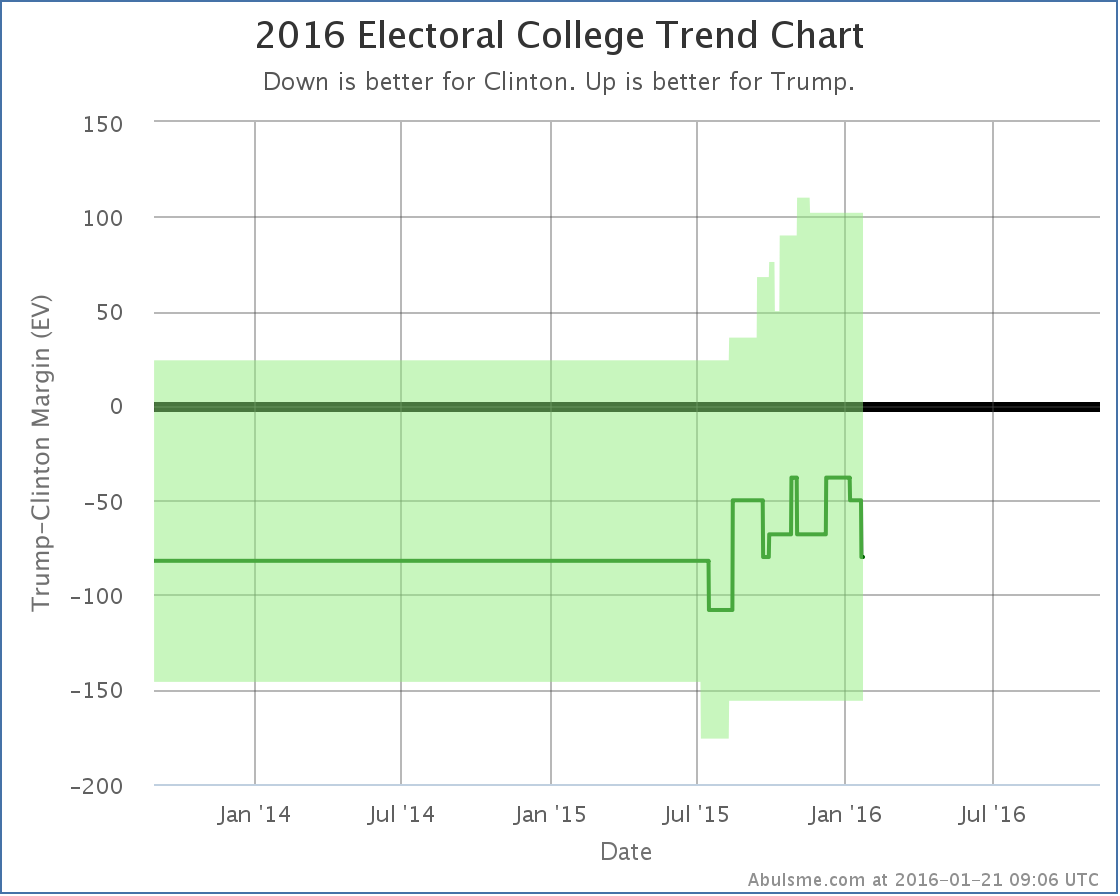
There really wasn’t polling on Trump before this summer, so most if not all of the movement seen here is not real movement, but just the process of getting enough polls to have a reasonable picture of how Trump is doing. The “expected” case doesn’t show a real trend, it has just bounced around a bit. Trump’s best case kept improving as more polls became available. At the moment, the state poll averages show a Clinton vs Trump race could reasonably be anywhere from a 156 electoral vote Clinton win to a 102 electoral vote Trump win, with the “expected case” being an 80 electoral vote win by Clinton. But this matchup DOES look like a real race, not a Clinton rout. Trump does better against Clinton than either Cruz or Bush. Of these four, only Rubio does better.
Or course, I should repeat all the usual caveats again. See the top of this post. There is still lots of time. Everything can and will change over the next few months.
291.9 days until the polls start to close. 11 days until the Iowa caucuses.
This whole thing is going to start moving very quickly very soon.
PS for Sanders fans: Although no match up vs Sanders has been polled enough to talk about in detail here, with today’s updates Sanders strengthened vs Rubio in North Carolina, while weakening against both Rubio and Cruz in Florida.
Note: This post is an update based on the data on ElectionGraphs.com. All of the charts and graphs seen here are from that site. Graphs, charts and raw data can be found there for the race nationally and in each state for every candidate combination that has been polled at the state level. In addition, comparisons of the best polled candidate combinations both nationally and each in each state are available. All charts above are clickable to go to the current version of the detail page the chart is from, which may contain more up to date information than the snapshots on this page, which were current as of the time of this post. Follow @ElecCollPolls on Twitter for specific poll details as I add them. And like Election Graphs on Facebook!
Another day with more Iowa and New Hampshire polls. This time no status changes in the five best polled candidate combinations in New Hampshire, but there were a couple of changes to talk about in Iowa. One of these favors Clinton, the other favors her Republican opponent. Lets take a look.
Clinton vs Trump
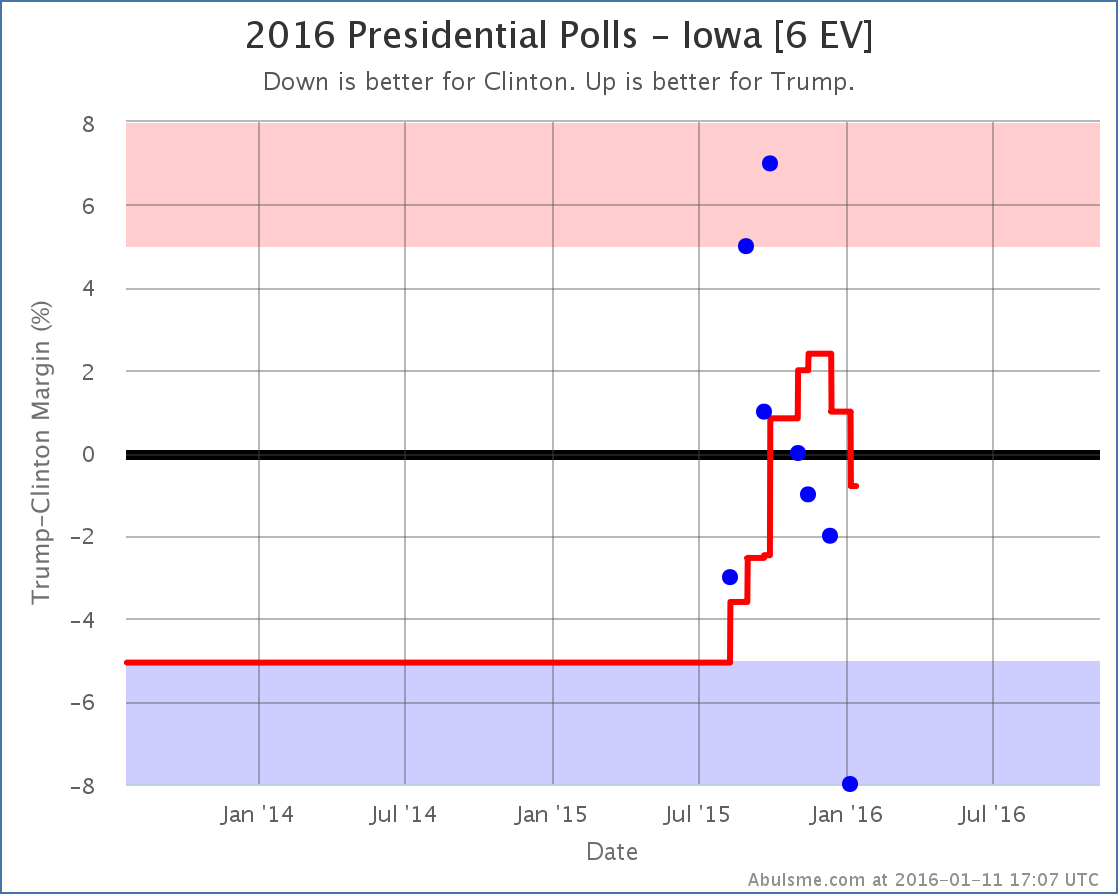
At the end of September after a series of good polls vs Clinton in Iowa, Trump had taken the lead in the Iowa poll average. Since then Trump hasn’t done quite as well, and with today’s addition of a Marist poll showing Clinton with up by 8%, the poll average once again shows a Clinton lead in Iowa.
Clinton’s is only ahead by 0.8%, which means Iowa is still close and could easily go either way. The five polls included in the average range from Clinton up by 8% to Trump up by 7%. That is a pretty big range!
The average puts Iowa in the “Weak Clinton” category though, so we give it to Clinton in the “expected case” for the moment. The updated national electoral college bubble looks like this:
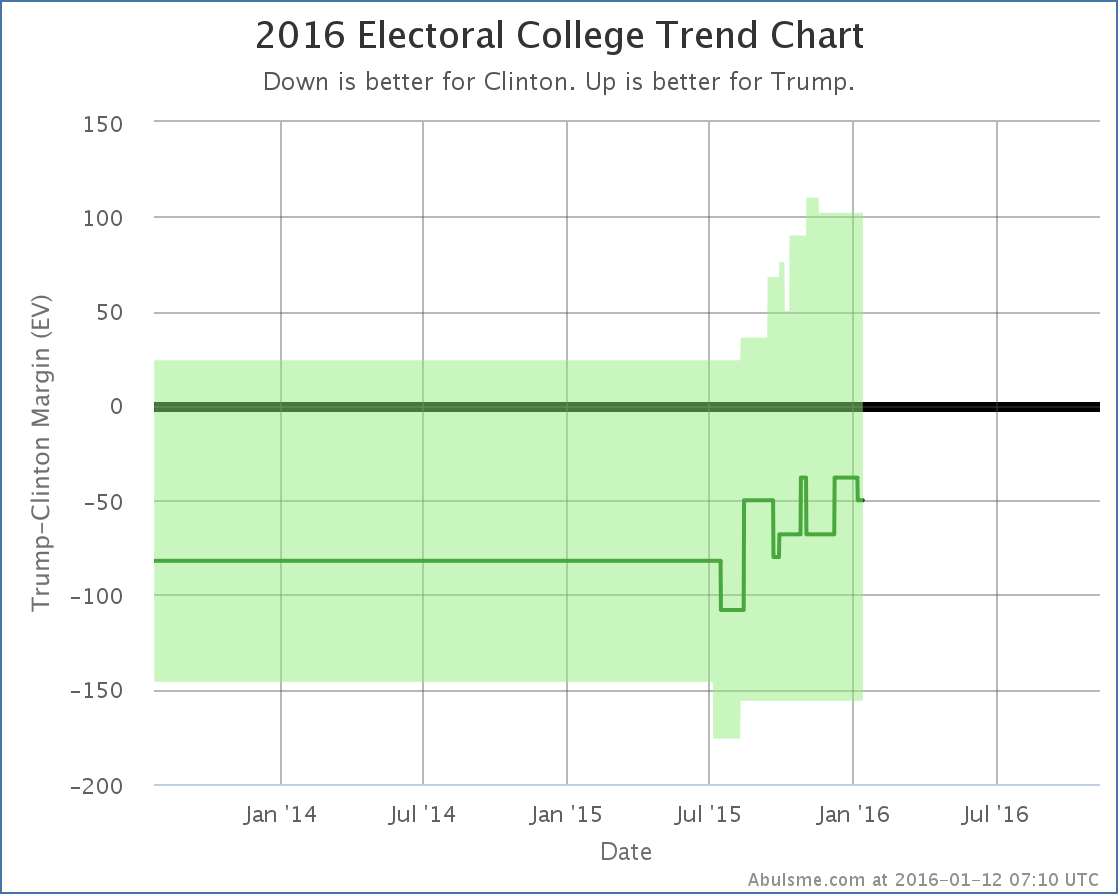
The last tick downward in the green center line is Iowa flipping to Clinton, which puts the “expected” Clinton vs Trump case at a 50 electoral vote Clinton win. But there are many close states still, so anything from a 156 electoral vote Clinton win to a 102 electoral vote Trump win would be within the realm of possibility given current state level polling.
This just goes to reiterate the point I made last month: “Do Not Underestimate Trump“. Conventional wisdom is that if the election comes down to Clinton vs Trump, it would be a Clinton runaway win, but poll data just does not show that right now.
(Insert usual comments here about how far we have until the election and how none of this is predictive yet. It only shows us a bit about how things look NOW, and even then only imperfectly due to the relative sparseness of state level polling.)
Clinton vs Cruz
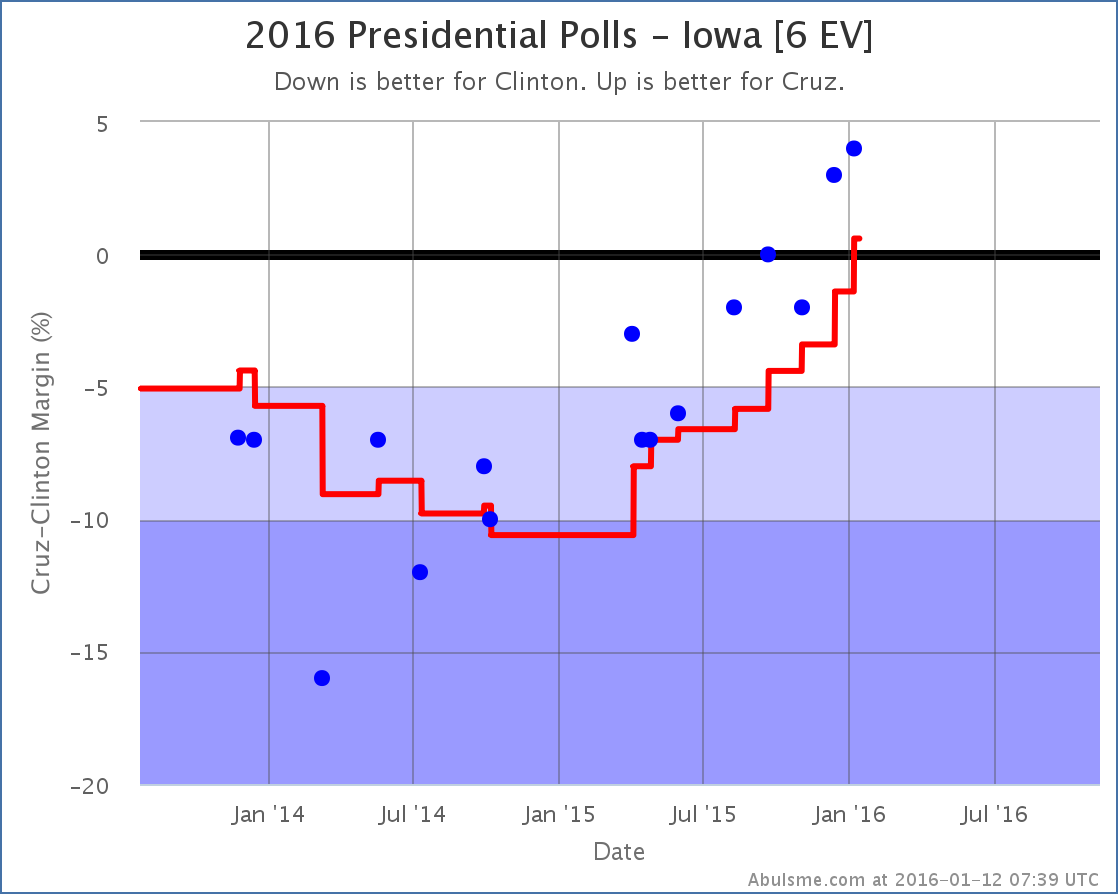
Unlike Trump, who rose for awhile and then has been falling, Cruz has been consistently improving in Iowa for the last year. With today’s update, he takes the lead in the poll average. It is just a 0.6% lead, but it is a lead, and we give him the state for now.
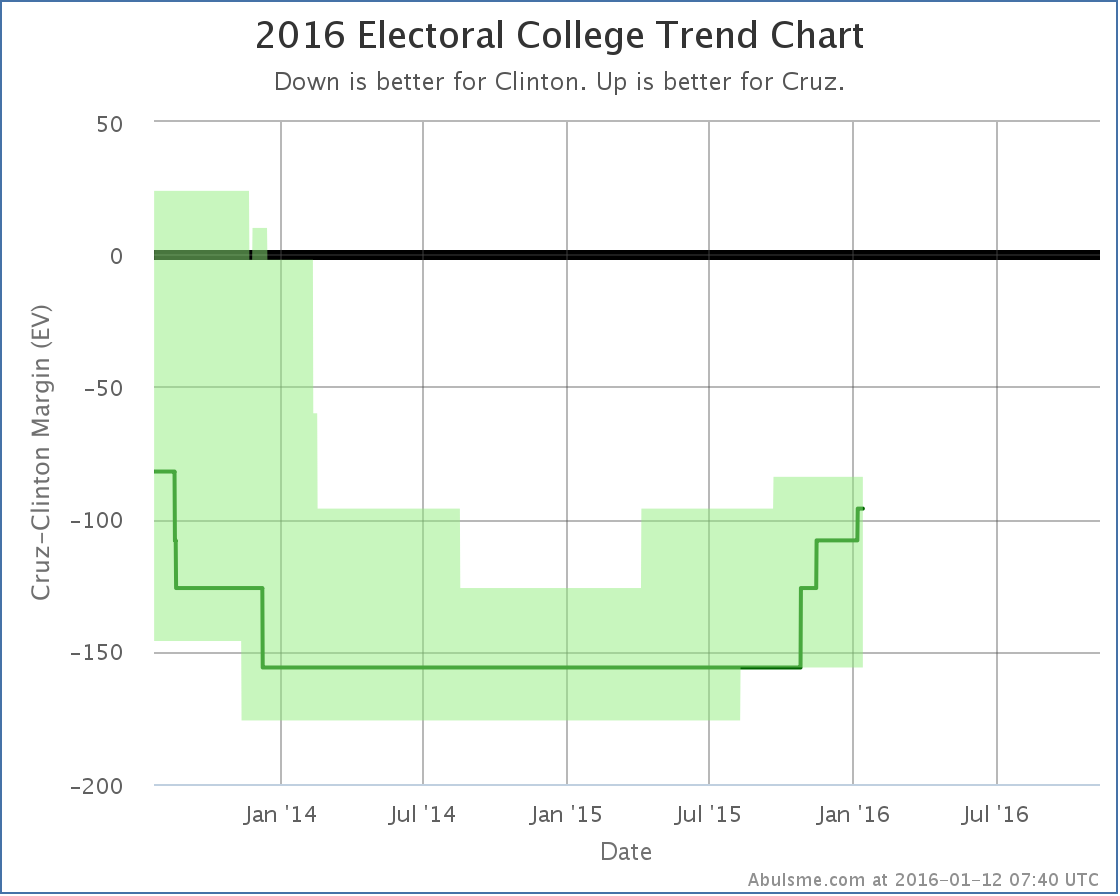
This brings Cruz up to… losing by 96 electoral votes to Clinton. Unlike Trump though, if you give him all the close states as well, it is still a loss to Clinton, just by only 84 electoral votes, which is still a pretty substantial Clinton win. Right now, Cruz is not “within range” of Clinton, while Trump is.
This is based on state level polls though, which at this point in the cycle lag national polls. The RCP average for Clinton vs Cruz shows Cruz ahead at the moment. If there indeed is a big enough move toward Cruz that he starts to be competitive, it will show up in the state level polls soon enough. That isn’t evident from the state data yet, but I can say that Cruz is competitive in Iowa, and currently has a very slight lead there.
Others
I don’t talk much about candidate combinations beyond the top five best polled, as their polling data is generally sparser, but just to note them in passing… Today’s batch of polls also flips New Hampshire from Clinton to Rubio, strengthens the Sanders lead over Cruz in New Hampshire, and moves the national tipping point in Sanders vs Trump further toward Sanders.
We’re going to see the pace of polling increasing dramatically as the primary season gets underway. As soon as we have clear front runners in both parties, we’ll stop seeing any polling at all for the other candidates and it will all be about the final general election match ups. Over the next couple months we’ll get to see just how quick that transition is.
301.7 days until the general election polls start to close.
Note: This post is an update based on the data on ElectionGraphs.com. All of the charts and graphs seen here are from that site. Graphs, charts and raw data can be found there for the race nationally and in each state for every candidate combination that has been polled at the state level. In addition, comparisons of the best polled candidate combinations both nationally and each in each state are available. All charts above are clickable to go to the current version of the detail page the chart is from, which may contain more up to date information than the snapshots on this page, which were current as of the time of this post. Follow @ElecCollPolls on Twitter for specific poll details as I add them. And like Election Graphs on Facebook!
Election Graphs will be rolling out our primary delegate race coverage before the Iowa caucuses, but in the mean time, we’ve just had the first state level general election polls of the New Year. It is a PPP poll in New Hampshire. There was only one candidate pair where the new polls changed my classification of New Hampshire though.
Clinton vs Bush

For all but a few days in November, Bush had held a lead against Clinton in my poll averages since the end of July. Just barely. But he had hung onto that lead. With the latest poll though, Clinton leads in four of the last five polls, and by enough to take a lead in the average. New Hampshire moves from “Weak Bush” to “Weak Clinton”. The lead is still slim at 2.2%, so the state is still very much in the “could easily go either way” category, but it is enough to put New Hampshire back in Clinton’s column in the case where we give each state to the current leader.

That little notch downward on the center line at the right hand side of the bubble is New Hampshire flipping to Clinton. We go from Clinton winning by 48 electoral votes, to Clinton winning by 56 electoral votes. Either way, Clinton is ahead, but the election is within the “bubble of uncertainty” since if you give Bush all the states where Clinton is ahead, but by less than 5%, Bush wins by 104 electoral votes.
A Clinton vs Bush matchup could go either way.
But, if the primary polls are to be believed, at this point Clinton vs Bush is a relatively unlikely scenario, so even though there were no other category changes, lets take a quick look at how the latest polls affected some of the other matchups.
New Hampshire Matchup Comparison
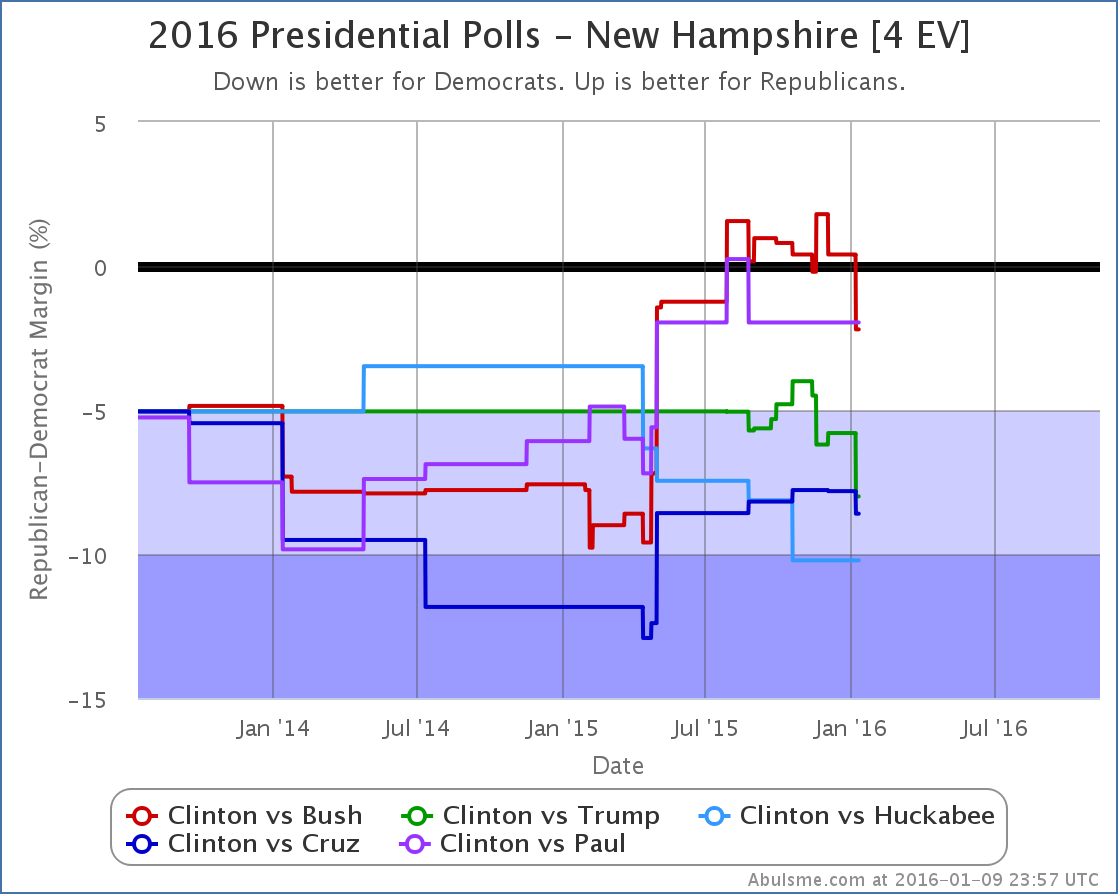
Looking at the five best polled candidate combinations nationally, the latest New Hampshire poll included three of the five (Bush, Trump and Cruz). In all three cases, the Republican weakened vs Clinton.
For Trump and Cruz though, this just meant Clinton’s already strong lead in New Hampshire got stronger. It makes no difference what so ever to their possible races against Clinton if they were to win the nomination.
Aside from Bush, the only one of these five that makes New Hampshire close is Paul, but that should be taken with a big grain of salt because he hasn’t been included in a general election match up poll in New Hampshire since August. So that data is a bit stale.
Looking beyond the top five though, to what is currently the sixth best polled combination by my metric, you actually see another candidate that makes New Hampshire close with Clinton, and in fact in that case the latest polls actually improved the Republican’s average. That would be Clinton vs Rubio:
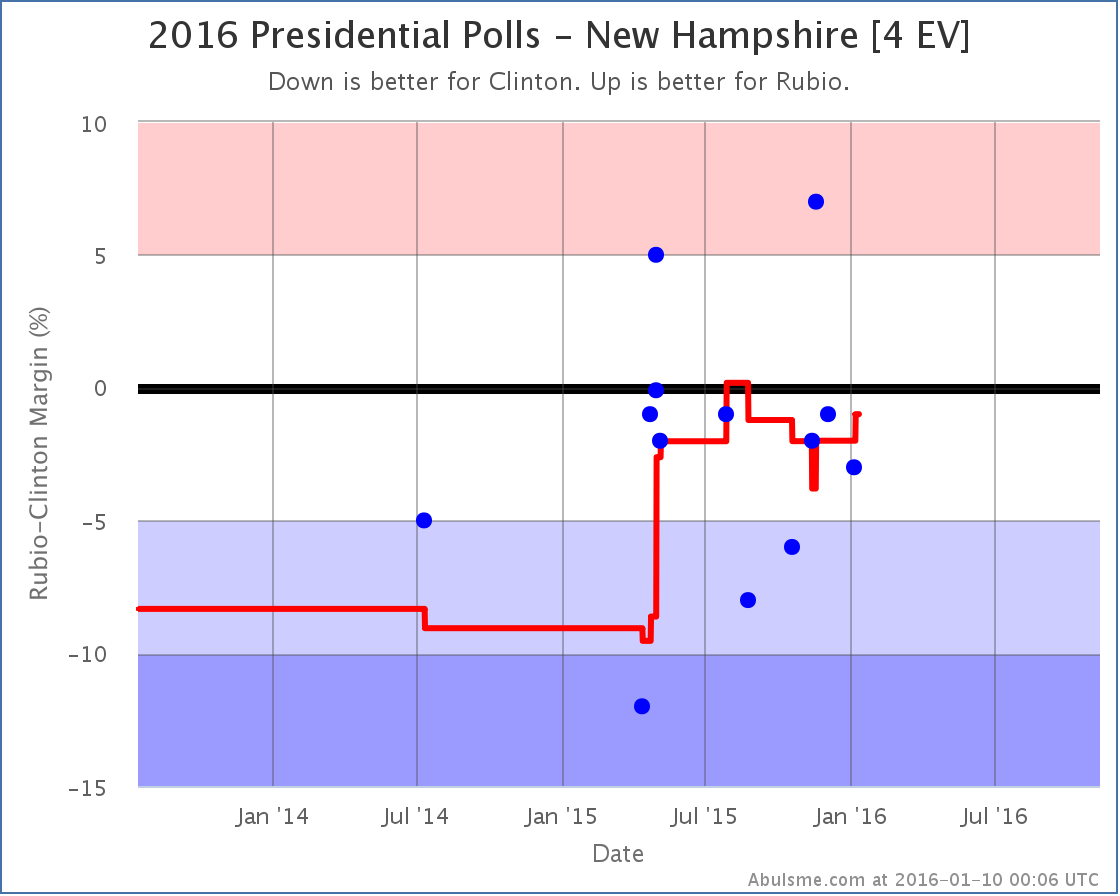
Of the 10 candidate pairs included in the latest polls… Clinton and Sanders vs Bush, Carson, Cruz, Rubio and Trump… Clinton vs Rubio is the only combination where the Republican’s poll average improved.
Does this imply larger things for the country at large? No, not really. New Hampshire is a special case in many ways. It is getting a huge amount of attention right now due to the upcoming primary. What is going on there right now in terms of public opinion may or may not be reflected in trends elsewhere.
So, as usual, we need to just wait for more polls. Which states get polled in the next few months is probably going to be highly influenced by the primary calendar as well, so the picture we see in the state polls will be warped a bit by that.
And of course once we have actual delegate numbers in both parties showing which candidates are actually leading in the nomination races, it starts changing perceptions of the general election, which may in turn cause more movement in the state polls.
Keep checking in with Election Graphs. We’ll be launching our delegate tracking soon, and it looks like the kind of election cycle where watching the delegate situation carefully may actually be needed.
In other words, we’re almost at Iowa, and things are going to get crazy. Hold on and have fun!
304.0 days until the general election polls start to close.
Note: This post is an update based on the data on ElectionGraphs.com. All of the charts and graphs seen here are from that site. Graphs, charts and raw data can be found there for the race nationally and in each state for every candidate combination that has been polled at the state level. In addition, comparisons of the best polled candidate combinations both nationally and each in each state are available. All charts above are clickable to go to the current version of the detail page the chart is from, which may contain more up to date information than the snapshots on this page, which were current as of the time of this post. Follow @ElecCollPolls on Twitter for specific poll details as I add them. And like Election Graphs on Facebook!
At long last, there has been enough state level polling in enough states over a long enough period of time that Trump makes it onto my “top five best polled candidate pairs” list. Until now, there simply was still more and better polling data around various other candidates, simply because they had been considered “contenders” for longer, and so therefore had amassed a wider variety of polls in more states. But no longer. It is time to look at Clinton vs Trump.
The various ups and downs over the last few months should not be considered real changes in Trump’s support. Instead, it is simply the the “average of the last five general elections” starting point that I use for each state gradually being replaced with real polling data on Clinton vs Trump. So we’ll only start looking at trends and changes starting now.
But where are we right now? With the usual caveats about how long it is until the election, lets do the rundown:


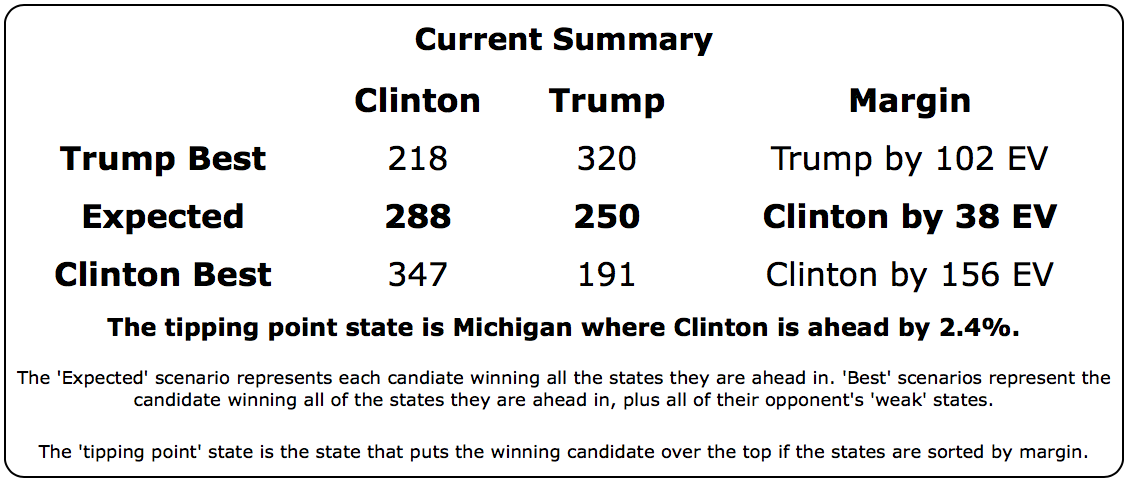
So… Clinton wins based on the current state level polling. But it is close. The tipping point state only has a Clinton lead of 2.4%. So 1.2% of people nationwide changing their minds, or the undecideds leaning Republican, or a systematic polling bias… all could easily wipe out that lead.
There is a lot of talk about how if Trump ends up as the nominee, we would see a Democratic win with margins unheard of since Reagan’s landslide over Mondale. This is by no means clear.
People point to how uncomfortable people are with Trump. For instance this CBS/NYT Poll from today shows 64% of the voting public “concerned or scared” about Trump becoming president. Sounds huge right? How can anybody win with numbers like that? But then you notice that, wait, in the same poll, 57% of the voting public are “concerned or scared” about Clinton becoming president. When you put those two together, it isn’t at all clear how things would work when you put the two head to head.
People talk about how Trump just couldn’t possibly win. How he alienates certain key voting blocs. How he will surely implode at some point. All sorts of reasons are mentioned. But a lot of them just boil down to “there is just no way, I don’t believe it.”
And they may be right that he won’t win. The analysis above shows Clinton winning over Trump. Most head to head polling nationally that I have seen shows Clinton winning. RCP’s Clinton vs Trump average has Clinton up by 3.3% today. But all indications with polling today show Clinton vs Trump as close. Not a Clinton blowout.
Now, to make explicit the caveat I noted at the top, there is a long time until the election. We don’t even have nominees yet. Trump winning the nomination is still one possibility among many. And even Clinton hasn’t wrapped things up yet. And a lot can happen in a campaign. General election polls this far out are NOT PREDICTIVE of the final result. They show us how things are RIGHT NOW at best. Things will move between now and next November.
But is there any reason to believe that all of the movement will be toward Clinton? That people will see the Clinton vs Trump comparison as the campaign rolls on and all gravitate to Clinton? It COULD work out that way.
But it is also quite possible that Clinton has bumps along the road that don’t look too great for her either. That the economy hits a rough spot. That Trump does what he has done so well against several primary opponents and finds just the right things to say at just the right moments to put Clinton in a negative light and turn people who were on the fence against her.
Clinton may well win a Clinton/Trump matchup. In fact if I had to wager on it right now, I’d bet on Clinton winning. And there is a chance Clinton could indeed pull off a landslide after a Trump melt down. But this is not a clear and obvious result at this point. Trump could in fact pull off a win. From the current position in the polls, he only has to move things ever so slightly to get there. Clinton winning, but not in a blowout, but in a close competitive race, is actually a very likely outcome.
Folks predicting that a Trump nomination automatically means a Democratic landslide… underestimate Trump at your own peril.
He has shown time and time again over the last few months that the “conventional wisdom” can be dead wrong. He may yet implode. But this should not be taken for granted. Right now he tops the polls nationally and in all the early states for the Republican nomination. And the general election polls show him doing better than Romney did in both the electoral college and the popular vote. To be clear… not winning… but doing better than Romney did… and within reach of a win if just a few things slid his way.
Looking for a second at other Clinton vs Republican pairings, and going past the “Top 5 best polled” combinations I usually talk about to pick up Rubio and Carson, lets see which of the Republicans are currently most competitive against Clinton based on my analysis. Here are the Top 5 Republicans in terms of how they fare in the Electoral College against Clinton:
- Clinton vs Rubio: Rubio wins by 2 electoral votes
- Clinton vs Carson: Clinton wins by 2 electoral votes
- Clinton vs Trump: Clinton wins by 38 electoral votes
- Clinton vs Bush: Clinton wins by 48 electoral votes
- Clinton vs Cruz: Clinton wins by 108 electoral votes
All the other Republicans are even further behind. For comparison, Romney lost by 126 electoral votes.
Rubio actually is slightly ahead right now, but barely. He is the only Republican who can say they are leading Clinton right now.
But really Clinton vs Rubio, Carson, Trump and Bush are all in the “too close to call” category. For each of these four Republicans, the “best case”, where the Republicans pick up the states where Clinton is ahead, but by less than 5%, result in a Republican win. These races are all competitive.
Cruz? Huckabee? Paul? Christie? None of these guys are even close in head to head matches with Clinton.
Trump is not in that category. Although meltdowns are always possible, and indeed, he hasn’t even gotten the nomination yet… Clinton vs Trump certainly has a strong possibility of being a close competitive race.
Do not underestimate Trump.
334.0 days until polls start to close on Election Day 2016. Buckle your seatbelt.
Note: This post is an update based on the data on ElectionGraphs.com. All of the charts and graphs seen here are from that site. Graphs, charts and raw data can be found there for the race nationally and in each state for every candidate combination that has been polled at the state level. In addition, comparisons of the best polled candidate combinations both nationally and each in each state are available. All charts above are clickable to go to the current version of the detail page the chart is from, which may contain more up to date information than the snapshots on this page, which were current as of the time of this post. Follow @ElecCollPolls on Twitter for specific poll details as I add them. And like Election Graphs on Facebook!
After a busy week including several days without power at Election Graphs HQ, I caught up on the 62 poll results that had been released in the last week. There were polls in eight different states (NV, IA, NH, SC, FL, CO, VA and WI) and for many different candidate combinations. With all of that though, there were only a few significant changes to the “best polled” candidate combinations that I comment on here.
Clinton vs Bush (best polled)
There were two polls for Clinton vs Bush in New Hampshire. Taken one by one, they show New Hampshire slipping back to the Clinton side of the fence for a few days, then back to a narrow Bush lead. Both taken together though, New Hampshire is in the same state as before this set of polls was included. This leaves the “expected case” at Clinton winning by 48 EV.
There was also a poll in Virginia though, and while the state was “Weak Clinton” before, and “Weak Clinton” after, Clinton’s margin increased, and improved Clinton’s “tipping point” against Bush. As a reminder, the tipping point is the margin in the state that would push the winning candidate over the edge. This can also be thought of as the amount the national polls would have to shift (assuming all states shifted uniformly) to change the winner. So it is essentially how close the race is taking into account the structure of the electoral college.
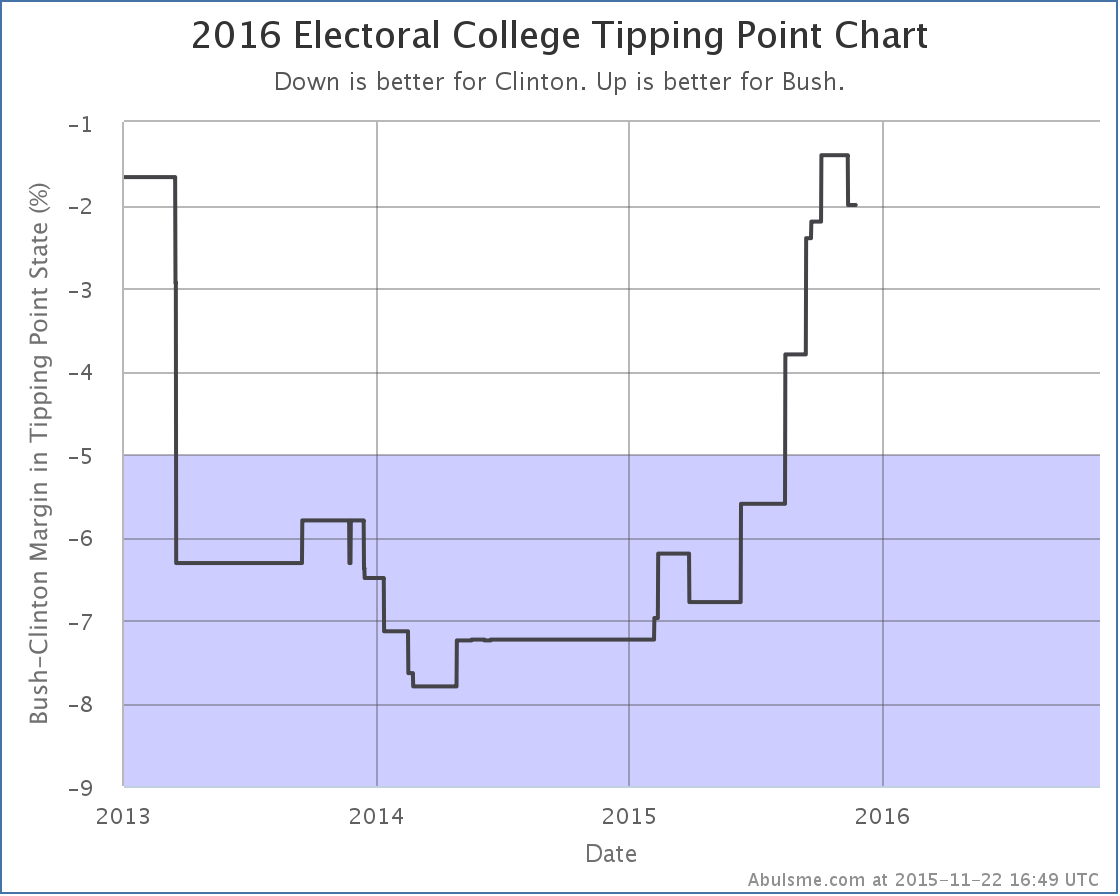
This is the first move toward Clinton in the tipping point against Bush since March. Is this a possible indication that Clinton has reached her floor and has started a rebound? Or is this just a blip, or something specific to Bush? Only more polls will tell.
Clinton vs Cruz (2nd best polled)
Since Clinton vs Cruz is just coming on to the five best polled list today, I won’t spend time looking at recent trends or changes. Instead, lets just look at where this combination sits right now:
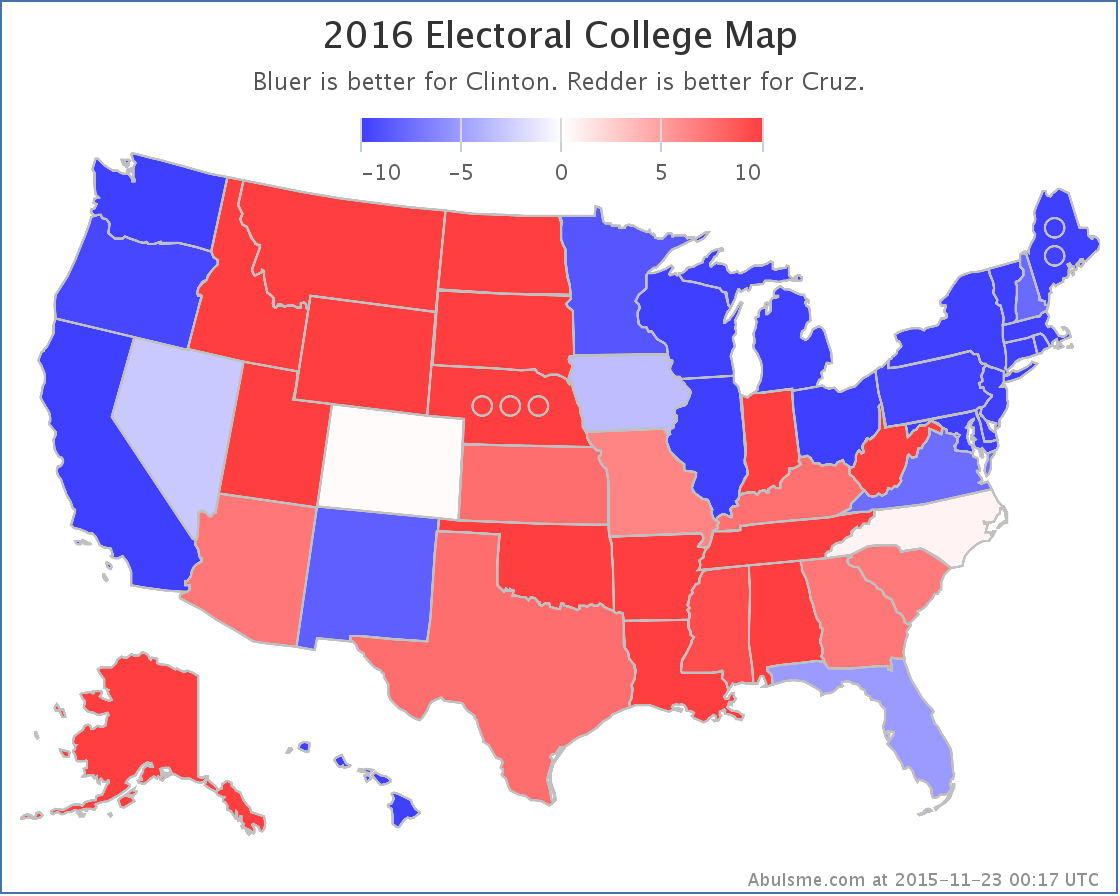

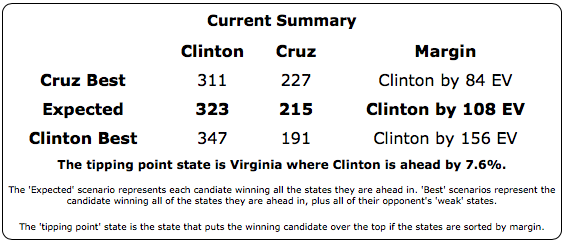
In other words, Cruz does pretty badly against Clinton at the moment. Rubio and Bush at least are making it close. Cruz is not.
Clinton vs Rubio (7th best polled)
Speaking of Rubio, with today’s update, Clinton vs Rubio actually falls off the “five best polled combinations” list, replaced by Clinton vs Cruz. I suspect Rubio may get back on this list soon, but in the meantime, here are the changes in this last update.
After a couple weeks with Rubio’s lead in Florida over 5%, with the latest update, the average falls to Rubio +4.1%, again making Florida a “Weak Rubio” classification, meaning that while Rubio is ahead, the state is within reach for Clinton, and could easily flip.
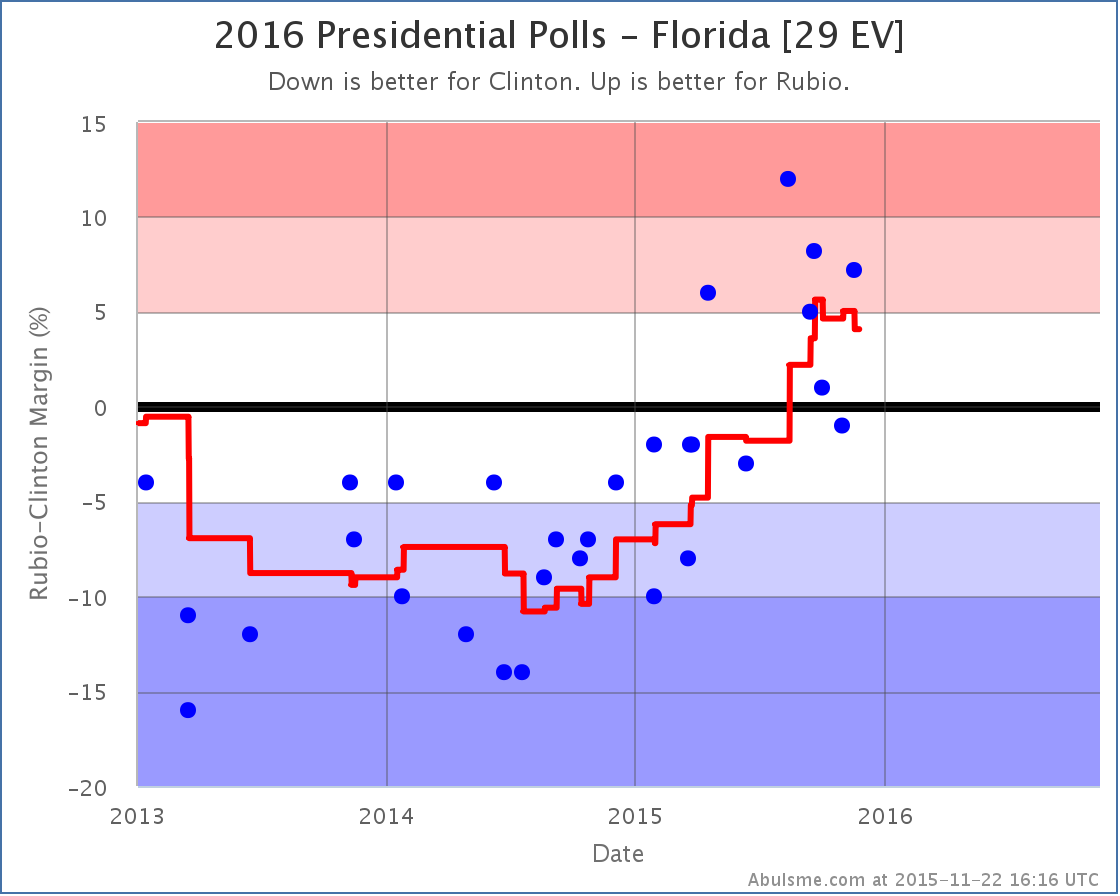
Florida is a big state, so this has a big impact on Clinton’s best case (where she wins all the Weak Rubio states in addition to the states she is actually ahead in).
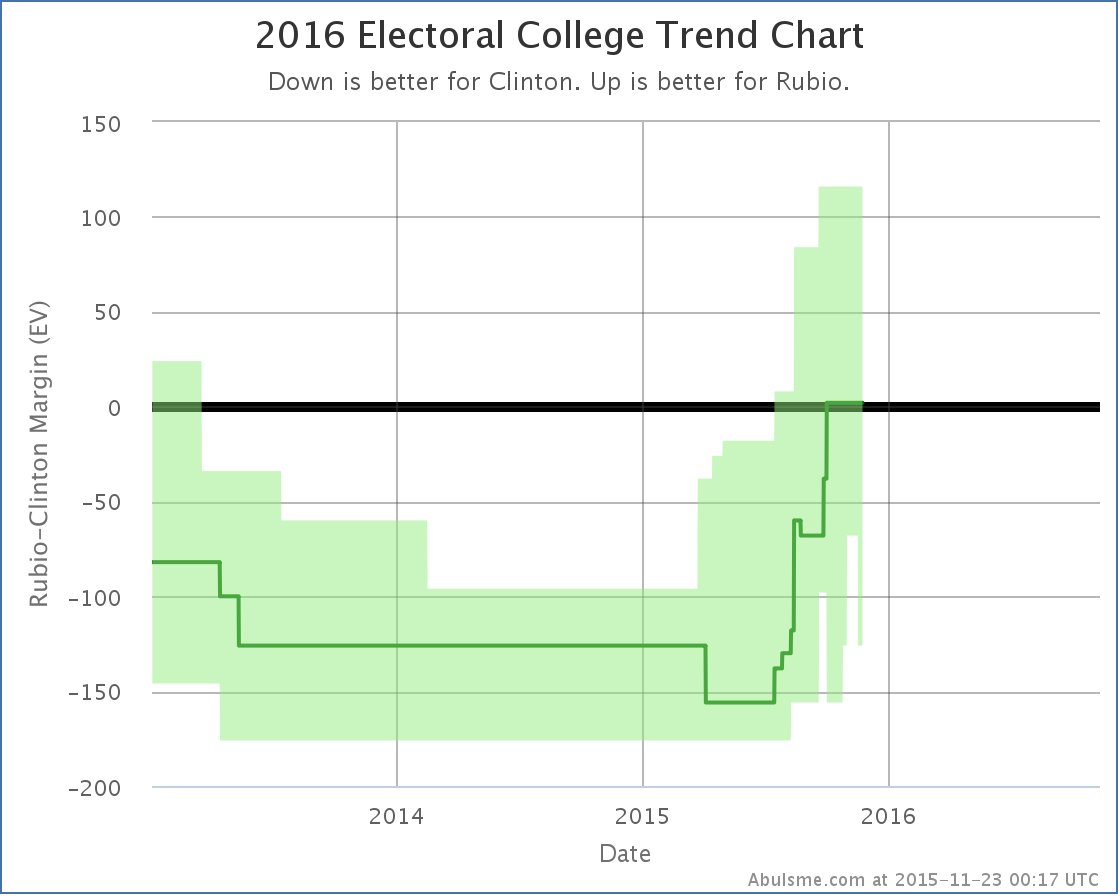
You can see the ragged lower edge of the “bubble” in the chart above. That is primarily Florida going in and out of the group of states considered possible for Clinton. For the moment, it is back in. The “expected case” is still Rubio winning by a razor thin 2 EV, but her best case is now back up to winning by 126 EV. So, Clinton strengthening?
Well, maybe, but at the same time, another poll increases Rubio’s average in Colorado, in turn improving Rubio’s tipping point against Clinton:
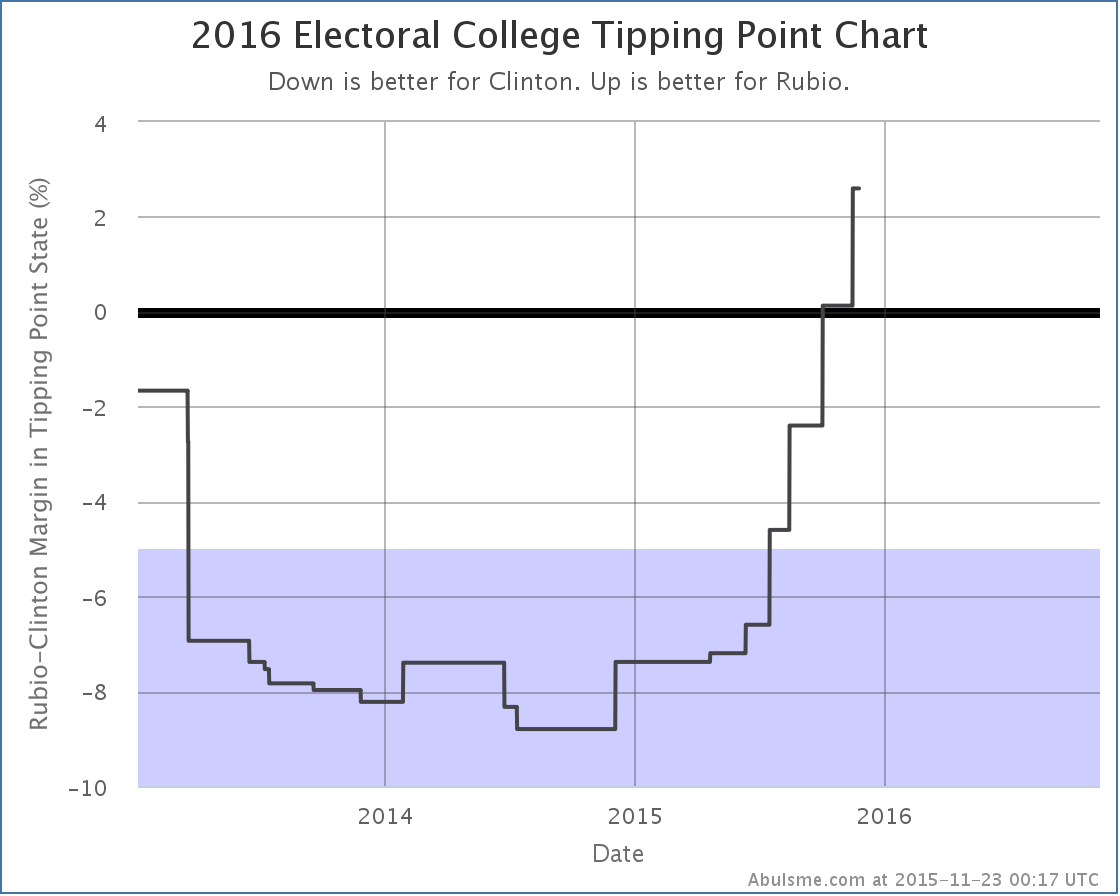
So, Clinton’s best case improves from winning by 68 EV to winning by 126 EV. But at the same time the tipping point moves from Rubio up by 0.1% in Colorado, to Rubio up by 2.6% in Pennsylvania. All in all this is a mixed bag of news, but on balance I’d say Rubio is better off here. So maybe don’t stock up quite yet on that Clinton recovery narrative.
Others
As usual, there are others getting lots of media attention currently that never-the-less have not yet had the sustained polling volume across a lot of close states to get on the “five best polled” according to my metric. This means looking at the results for those candidate pairs is a bit less reliable, but since there is continued interest, here are links to a few of those along with the current “expected” result for each:
351.9 days until the first general election polls start to close. A lot will change before then. Stay tuned.
Note: This post is an update based on the data on ElectionGraphs.com. All of the charts and graphs seen here are from that site. Graphs, charts and raw data can be found there for the race nationally and in each state for every candidate combination that has been polled at the state level. In addition, comparisons of the best polled candidate combinations both nationally and each in each state are available. All charts above are clickable to go to the current version of the detail page the chart is from, which may contain more up to date information than the snapshots on this page, which were current as of the time of this post. Follow @ElecCollPolls on Twitter for specific poll details as I add them. And like Election Graphs on Facebook!
For once this is an update with good news for Clinton! Specifically, the latest Florida poll brings the state back into reach…
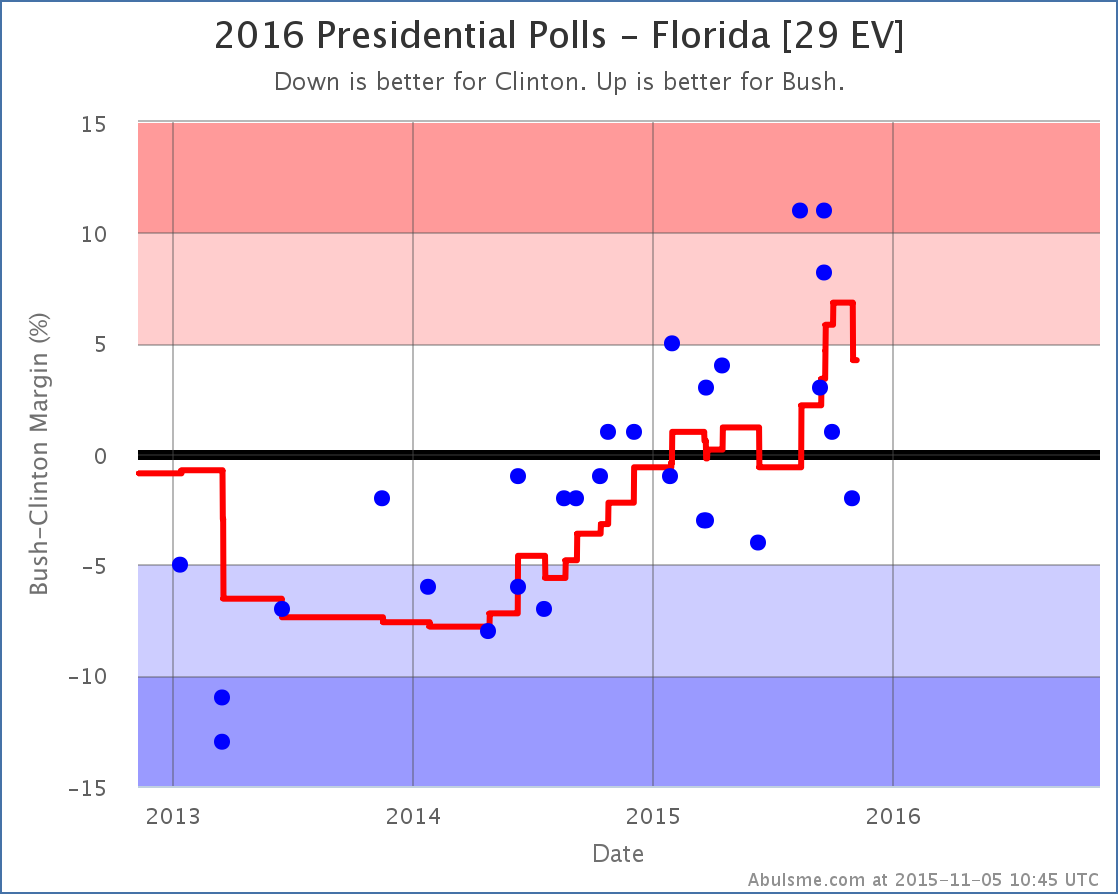
Well, into reach against Bush. Bush hasn’t been having the best time of things lately. But Bush now leads Clinton by only 4.2% in our average, so we consider Florida one of those states that could go either way.
Meanwhile though, against Rubio…
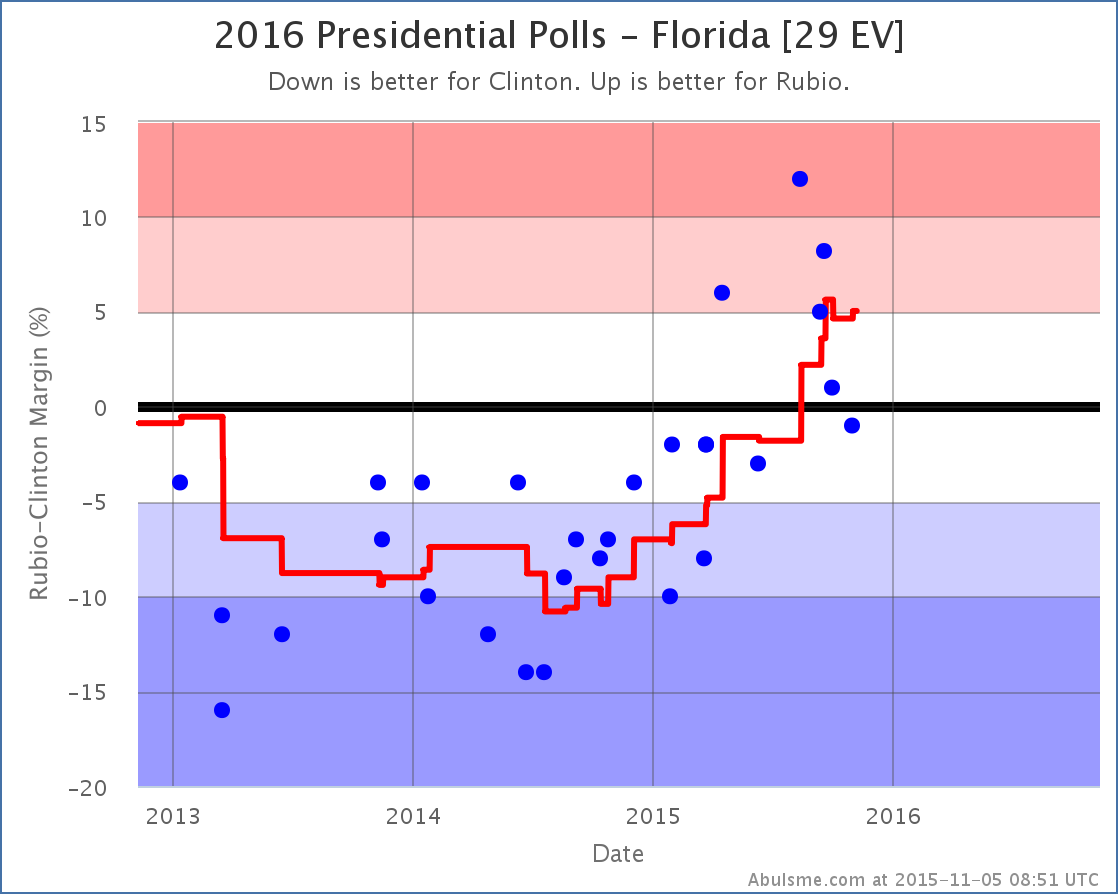
With this latest poll Rubio’s lead grows to just barely over 5%, so once again we take it out of the “possible” list for Clinton.
So Clinton gains Florida as a possible pickup against Bush, but loses it agains Rubio. Is that a wash over all? Probably.
It is also worth noting though that in both of these cases the averages are very close to the 5% boundary between the actually pretty arbitrary “Weak” and “Strong” categories. It should not be surprising if the next polls just reverse today’s changes.
For the moment though:
- Clinton’s best case vs Bush improves from winning by 98 electoral votes to winning by 156 electoral votes.
- Clinton’s best case vs Rubio drops from winning by 126 electoral votes to only winning by 68 electoral votes.
The “expected” cases, where each candidate just wins the states they lead in the average, remain Clinton winning by 48 electoral votes against Bush, and losing by 2 electoral votes against Rubio.
369.1 days until the first polls start to close.
Note: This post is an update based on the data on ElectionGraphs.com. All of the charts and graphs seen here are from that site. Graphs, charts and raw data can be found there for the race nationally and in each state for every candidate combination that has been polled at the state level. In addition, comparisons of the best polled candidate combinations both nationally and each in each state are available. All charts above are clickable to go to the current version of the detail page the chart is from, which may contain more up to date information than the snapshots on this page, which were current as of the time of this post. Follow @ElecCollPolls on Twitter for specific poll details as I add them. And like Election Graphs on Facebook!
|
|















































